February 24 - March 2, 2019: Issue 394
Pittwater Roads II: Where The Streets Have Your Name - Scotland Island
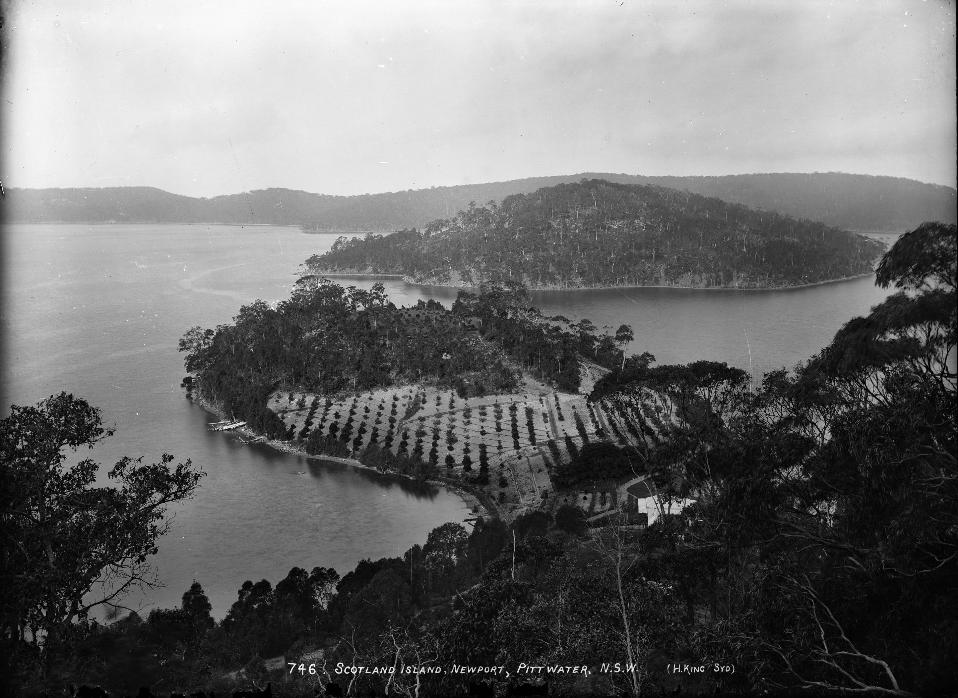
'Scotland Island, Newport, Pittwater, N.S.W.', photo by Henry King, Sydney, Australia, c. 1880-1886. From Tyrell Collection, courtesy Powerhouse Museum - taken from above Rocky Point Peninsula and Lovett's Bay looking east.
Those leafy avenues and streets named for people often show the development of our area and the change from being a place where maize (corn) was grown, where orchards flourished and fishermen sent their catch to market to a series of small villages that progressed to become a suburban home for families.
Of course in Pittwater we have one emerald jewel where the ways are more alike leafy lanes in places and the 'roads' more a suggestion of a wending track than sealed asphalt drilled with white lines indicating formalised way of passage - and that place is Scotland Island.
Originally named 'Pitt Island' by Governor Phillip when he explored Broken Bay in March 1788, the island was renamed by the first European to be granted Scotland Island, Scotchman Andrew Thompson. The 120 acres comprising the island were granted on January 1st 1810, as a reward for his flood rescue work on the Hawkesbury River.
Although he clearly frequented Pittwater and Scotland Island, named for his homeland and perhaps due to the similarity of the green hilled and blue watered estuary to his original home, his main sphere of work was at Green Hills, soon to be named 'Windsor'. His responsibilities were varied and large and there seemed no field he was not involved in. Horses as well as cattle were bred, grains were harvested and shipped to town, and he was also in charge of labour gangs working on creating roads and, under Captain Philip Gidley King RN, who became the third Governor of NSW on 28 September 1800 and encouraged the building of wharves, bridges and ...:
Robert Lathrop Murray moved to Tasmania and became involved in local press there, his campaigns amounting to a fight for free speech in some instances. His eldest son, D'Arcy, who became a member of parliament, also undertook a similar role, and was based at Launceston within metres of the McMillan/Overall Drapery business set up there, but it does not appear that Scotland Island came into the McMillan family at this time.
The McMillans also moved from Hobart to Launceston, setting up a new Drapers business there. James McMillan, after writing a Will leaving his assets to his wife and in trust for his daughters, was one of the 220 souls 'Lost At Sea on "London" in Bay of Biscay' on January 11th, 1866. It may be he as on a buying trip when this occurred.
NOTICE. From and after the 1st proximo, this journal will be conducted by the undersigned, under the style and firm of Goodwin and Murray, Proprietors, the immediate management thereof, devolving upon Mr. D W. L. Murray.W. L. GOODWIN. D'ARCY W, L. MURRAY. Office of the Cornwall Chronicle, March 17th, 1860.NOTICE TO THE AGENTS OF THE CORN-WALL CHRONICLE. — Agents are particularly requested to furnish this Office with a list of Subscribers in their respective districts, and also, with an account of monies received by them. It will be understood that these statements are absolutely essential to the correct delivery of accounts from this Office. Office of Cornwall Chronicle,19th March, 1860. Family Notices. (1860, March 24). The Cornwall Chronicle(Launceston, Tas. : 1835 - 1880), p. 4. Retrieved from http://nla.gov.au/nla.news-article65988294
Mary Helen McMillan was born January 4th, 1857 to James Coutts Mcmillan and Mary (nee Overall). Her father was a draper, originally from Airntully in Scotland, a village known for 'Airntully, Perthshire, Scotland. Airntully in 1846. Airntully, or Arntully, a village, in the parish of Kinclaven, county of Perth, 8 miles (N.) from Perth; containing 159 inhabitants. This place, of which the houses are scattered in every direction, was of greater extent than it is at present; and though it has, of late years, considerably decreased in size and population, it still exhibits a striking picture of the ancient villages of the kingdom. It is now chiefly inhabited by weavers for the linen manufacturers of Cupar-Angus, Blairgowrie, and Newburgh; and attached to each of their cottages, is a portion of land sufficient to maintain a cow, and to yield meal and potatoes for the supply of their families.'
Henry Charles White was a grazier from a formidable family of landowners, sheep developers and pedigree horse breeders. Family records indicate he, with his first wife, used to bring their children to holiday in Tasmania during hotter months. With wife Isabella Mary Anne (nee Lowe) he had four daughters and two sons. Tragically Isabella died in childbirth in 1875.
Under the many anecdotes written about her father (see his section below) we read this gentleman was near Launceston soon after the passing of his wife buying a prize ram. He is supported vocally by the owner of a Launceston newspaper, the also soon to pass away eldest son of Mr. Murray, the original owner of Scotland Island, and one time acquaintance of Mary's father. At age 20, as a 'Minor' according to her marriage certificate, Mary marries H. C. White:
WHITE—McMILLAN— On the 10th March, by the Rev. James Lindsay, at the residence of the bride's mother, H. C. White, of Glenalvon, Murrurundi, New South Wales, to Mary Ellen, eldest daughter of the late J. C. McMillan. Family Notices. (1877, March 13). Launceston Examiner (Tas. : 1842 - 1899), p. 2. Retrieved from http://nla.gov.au/nla.news-article37147181
Around the same time, in 1887 a group of gentleman proposed to build a tramway all the way to Pittwater from the other side of the Spit. A company, the 'North Shore, Manly, and Hawkesbury River Tram and Railway Company' was registered in Melbourne. As there was talk during this time of moving the Quarantine Station to Scotland Island, and later on, using it as a Naval College site (as well as Barrenjoey Headland), there would be continued debate regarding the government not buying the island for decades.
A few years have made a great change in Pittwater. The western shore of the harbour is all under cultivation. Fruit trees of all kinds flourish there, and some vegetables can be produced a fortnight earlier than around Sydney. Fish is abundant in the harbour. We assisted at three hauls of the net of our host, Mr. Bulfin. 'Our bachelor' and another gentleman donned fishing garb for the occasion, put their shoulders to the wheel, or rather to the ropes and towed very well indeed for amateurs. Our labours were attended with but moderate success.
There is much inquiry for land in Pittwater now, the prospect of the tramway thither doubtless stimulating it. Scotland Island, in the middle of the harbour, area about 150 acres, has been sold to a Melbourne company for £2,500. There is some speculation as to what they are going to do with it. The impression prevails that it is to be utilized for a marine public resort.
The romantic marine retreat of the late lamented Mr. Dalley on Cabbagetree beach, underlying Bilgola head on the Pacific shore, has been purchased by Mr. Jackson. Mr. J. M. Taylor, our bachelor (so designated from having obtained his B.A. degree as an evening student at the University the morning of our visit), was delighted with Pittwater. As a holiday retreat he would prefer it to the mountains principally because 'There is a society where none intrudes By the deep sea, and music in its roar.' C. B. PITTWATER. (1889, January 12). Freeman's Journal (Sydney, NSW : 1850 - 1932), p. 17. Retrieved from http://nla.gov.au/nla.news-article115380870
The tram scheme didn't go to plan. It wasn't until another 15 years or so elapsed before the tracks made it all the way to Narrabeen - and that's where they stopped. In the meantime, offloading the island asset may have seemed a good idea:
Scotland Island, near Pittwater, New South Wales, is for sale, but the Government, on being questioned by Mr. Levien in the House, declined to become the purchaser. The original Scotland, although not an island, is not so far from one which the Government of a century ago bought right out for some millions of money and some dozens of decorations. When one of the vendors, a member of the College Green Legislature, was upbraided in after years for having sold his country he thanked God that ' he had a country to sell.' Islands, however, are indifferent property at the best, as Britain, and Spain, and France, and China have found with regard to Ireland, and Cuba, and Mauritius, and Formosa. Perhaps it's as well, therefore, that the New South Wales authorities hold their hands when such goods are in the market. N'IMPORTE. (1896, September 19). The Sydney Mail and New South Wales Advertiser (NSW : 1871 - 1912), p. 588. Retrieved from http://nla.gov.au/nla.news-article163787177
A few years later another item shows there is a mortgagee and that the island did not sell:
AN ISLAND OFFERED AT AUCTION. That picturesque spot at Pittwater known as Scotland Island, containing about 130 acres, was offered at auction yesterday by Messrs. Richardson and Wrench, Limited, by order of the mortgagee. After £1100 had been bid, the property was withdrawn, that price being much under the mortgagee's valuation. AN ISLAND OFFERED AT AUCTION. (1900, May 5). Evening News (Sydney, NSW : 1869 - 1931), p. 6. Retrieved from http://nla.gov.au/nla.news-article113717954
From 1900 to 1905/09 Mary Helen White was very busy being an entrepreneur. H. C White may have been doing too much for too long, he certainly did a lot for a long while, and a shift towards other enterprises, supported by how much their country estate produced each year, made building up other assets a natural for this intelligent woman.
It was during this time Mary lost her husband and a little while later, her youngest daughter with him. Reports state they were living at Greenoaks at this time and he, being ill, had gone south to rest.
WHITE. - On February 24, at Painswick, Audley-street, Hobart, Henry Charles White, of Havilah, Mudgee, New South Wales, aged 67 years. Family Notices. (1905, February 27). The Mercury (Hobart, Tas. : 1860 - 1954), p. 1. Retrieved from http://nla.gov.au/nla.news-article12292778
It is during these years that Mary Helen White bought Scotland Island - a few later articles, and taking into consideration her own family heritage and her first husband's, as well as Mr. Murray's, indicate where some of these early chosen names for the roads on Scotland Island may stem from:
The appearance of her second marriage announcement in a Queensland newspaper may have been placed there to allow her son 'Roy' to read as he was living and working on the Queensland 'Loudon' estate:
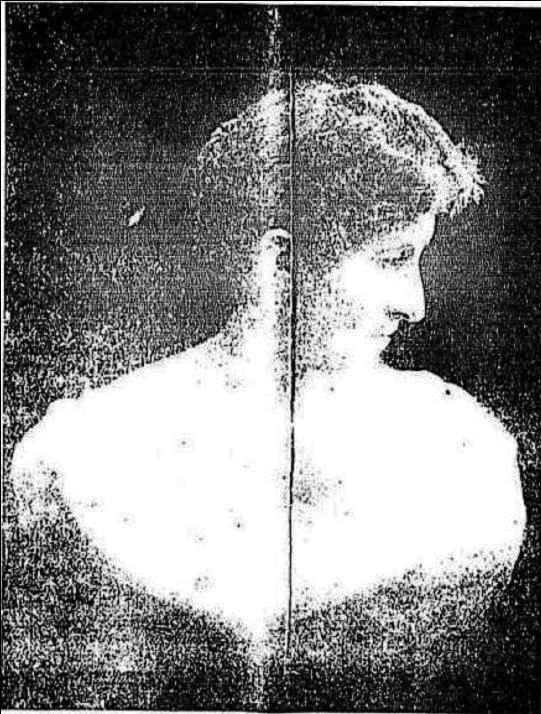 MORNER-WHITE.- June 29, at St. Margaret’s, Westminster, by Canon Hensley Henson, assisted by the Rev. Cecil Knox, Count Karl Birger Morner, only son of the late Count C. H. Morner, of Hvilah, Norrkoping, Sweden, to Mary Helen, daughter of the late J. C. McMillan, of Airntully, and a widow of the late H. C. White, of Havilah, New South Wales. Family Notices. (1910, September 10). The Brisbane Courier(Qld. : 1864 - 1933), p. 4. Retrieved from http://nla.gov.au/nla.news-article19682179
MORNER-WHITE.- June 29, at St. Margaret’s, Westminster, by Canon Hensley Henson, assisted by the Rev. Cecil Knox, Count Karl Birger Morner, only son of the late Count C. H. Morner, of Hvilah, Norrkoping, Sweden, to Mary Helen, daughter of the late J. C. McMillan, of Airntully, and a widow of the late H. C. White, of Havilah, New South Wales. Family Notices. (1910, September 10). The Brisbane Courier(Qld. : 1864 - 1933), p. 4. Retrieved from http://nla.gov.au/nla.news-article19682179
Count and Countess Morner (Picture at right) from: (1911, January 7). The Newsletter: an Australian Paper for Australian People (Sydney, NSW : 1900 - 1918), p. 4. Retrieved from http://nla.gov.au/nla.news-article102801444
A Notable Marriage. The Count and Countess Morner. A notable marriage has just been celebrated in London, which will prove of particular interest to Australians. That well-known and distinguished Swedish consul, Count Morner, so popular in Sydney, was married to a no less distinguished Australian, Mrs. H. C. White, of Havilah, Mudgee. The event was purely a love affair, the Count being attracted to the lady by her remarkable personality, her refinement and her artistic tastes. Count Morner is one of the most notable men in the Swedish foreign service; he is a gentleman of leisure and of ample means, and has a European reputation as a scholar, scientist, poet, and author. The German Government, it maybe mentioned, have adopted for all German schools, as part of their standard readers on language, Count Morner's work on Constantinople. In his own country, the Count stands high in royal and national favor, and his castle is that of one of the oldest Swedish families. He has found for wife a splendid type of Australian. The lady's high, womanly qualities place her in the rank of the first women of the time; and it is probable her equal in finance and tact will not be found anywhere. The way the lady has managed and developed her own estate of Havilah, and other properties of over a million sterling, stamps her as a person of superior mind and great foresight. Count Morner recently came into considerable political prominence in Sydney, over his conflict with Premier Wade. He carried off all honors of the contest, and won the approbation of all classes in the matter. A Notable Marriage. (1910, July 9). The Newsletter: an Australian Paper for Australian People (Sydney, NSW : 1900 - 1918), p. 4. Retrieved from http://nla.gov.au/nla.news-article102799730
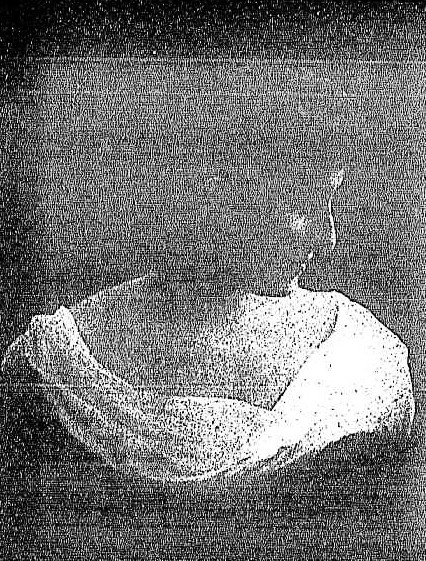 The marriage produced one child, 'Felicite', but did not last long - reports such as that below indicate two strong people do not always meld well. There was also WWI to place distance between them. During this time Countess Morner purchased War Bonds in England
The marriage produced one child, 'Felicite', but did not last long - reports such as that below indicate two strong people do not always meld well. There was also WWI to place distance between them. During this time Countess Morner purchased War Bonds in England
Countess Morner returned here from Sweden last year on account of the land tax, and now she is here again because of the Income tax, having great estate in Queensland as well as In New South Wales. Countess Morner used to be known as Mrs. "Havilah" White. Her friends do not object to her presence In Sydney, as her little dinner parties at Beulah Flats are very lively, even In the dog days, Mrs. White married Count Morner, than Consul for Sweden, who had been divorced. His former wife married some high official at Court, and when the now Countess Morner and the Count were presented to their Swedish Majesties it fell to the lot of the official and his wife to receive them. AN IDLE WOMAN'S DIARY. (1912, February 16). Newcastle Morning Herald and Miners' Advocate (NSW : 1876 - 1954) , p. 7. Retrieved from http://nla.gov.au/nla.news-article133955772
Lieutenant Jas. Anderson and Mrs. Anderson, and Countess Morner are among those who have booked passages by the next steamer sailing for America. PERSONAL. (1918, January 4). The Sydney Morning Herald(NSW : 1842 - 1954), p. 6. Retrieved from http://nla.gov.au/nla.news-article15789576
A marriage has been announced to take place at Washington, (U.S.A:)shortly between the Marquis of Ruvigny and Raineval, and Countess Helen Morner, of Sydney, and has an added interest for Australians, from the connection between the title of Lord Portarlington (one of the few Peers who has married an -Australian—he married Miss Yuill), -and that of the Marquis. The first Viscount Portarlington was the second 'Marquis of Ruvigny and eighth of Raineval. His father has been ambassador at the English Court, and at the time of the Huguenot persecution, he left France and offered his services to England. So much were they appreciated that he was afterwards created Viscount Portarlington and Baron Galway and later still Earl of Galway. Dying unmarried, his English titles became extinct, and only the French titles were inherited by his nephew, from whom the present Marquis is descended. The Marquis and his younger son are the only living representatives of the family — the Marquise, her elder son, (who was killed in action) and only daughter having all died within the past three years. PERSONAL . (1918, January 11). Daily Advertiser (Wagga Wagga, NSW : 1911 - 1954), p. 3. Retrieved from http://nla.gov.au/nla.news-article141948442
This marriage was cut short by the Marquise of Scotland Island dying at sea from a heart attack:
Countess Morner. New South Wales loses an interesting figure by the death of Countess Morner, the information of which was received by the late lady's agent, Mr. H. S. Harvey, Bridge-street, last week. The Countess will be remembered as Mrs. Henry White, of Havilah Station, before her second marriage. Among her many possessions, which included the Astoria Flats at Kirribilli and Lowden Station, Queensland, she had the unusual one of an island. Scotland Island, at the entrance to the Hawkesbury River, belonged to Countess Morner. The Countess was on her way to England when she died. She and her little daughter, aged 8 years, were apparently the only passengers on the Port Elliott, and much sympathy will be felt for the child. Countess Morner. (1921, August 14). Sunday Times (Sydney, NSW : 1895 - 1930), p. 15. Retrieved from http://nla.gov.au/nla.news-article123244777
Thrice Married, Twice Titled and Fabulously Rich COUNTESS, MARQUISE, ' MRS.'
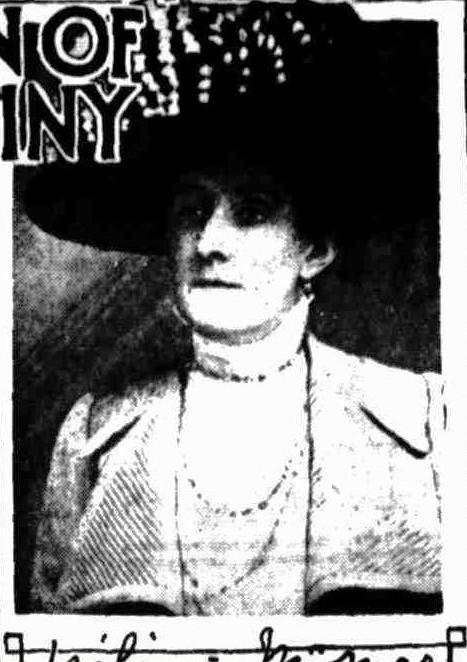 AFTER the auctioneer's hammer had banged out the final notes of its mournful serenade and the footsteps of the last lodgers down the staircases had echoed away, the memory of a mysterious and fascinating woman still lingered in the deserted halls of 'Brae-burn' private hotel, on the Kirribilli waterfront.
AFTER the auctioneer's hammer had banged out the final notes of its mournful serenade and the footsteps of the last lodgers down the staircases had echoed away, the memory of a mysterious and fascinating woman still lingered in the deserted halls of 'Brae-burn' private hotel, on the Kirribilli waterfront.
SYDNEY read with interest of the final scenes in the strange eventful history of this huge apartment house towering above the harbor almost within the shadow of the North Shore Bridge. A COMEDY of bailiffs closed the chapter.
WHO of all the thousand, who peered afterwards at this great castle from their ferry boats thought of Mary Helene de Massue, Marquise de Revigny, formerly the Right Hon. Helene Countess Morner, prior to that, Mrs. H. C. White, wife of a wealthy Mudgee grazier, thoroughbred owner, originally a nursery governess, of Tasmania ?
The Hotel Braeburn was the last link binding Australia with the memory of this remarkable woman. Originally known as 'Beulah' Flats, later again as the 'Astoria,' this accommodation house had Just about as strange and stormy a career as that of the mysterious countess who built it. A fortnight ago a posse of bailiffs besieged the flats and laid claim by law to all the goods and chattels contained therein. When this unpleasant little fact was explained to the tenants, a Venetian touch was added to a tragic comedy which followed. Sorties In rowing boats outside the windows were resorted to in a desperate attempt to rescue the nominally-seized goods. The hotel Is the property of Emanuel Myerson to whom It was knocked down about two years ago for what then seemed a bargain price of £23,000. He in turn leased it at a rental in the vicinity of £70 weekly. All this was purely business. Cold and unsentimental. But the other side of the picture — going back to when the flats first sprang into being, with roof garden complete — there remains the memory of one of Australia's most picturesque figures — a woman, thrice married, twice-titled, fabulously rich, conspicuous for her grand scale of international speculations both in husbands and stocks, and yet the saddest and loneliest of women, who found her final rest in that dreariest of all cemetries, the open sea, where not even tombstones keep each other doleful company. Here then we introduce Mary Helene de Massue Marquise de Ruvigny, of Tasmania. As to her original surname there is some doubt.
One of her marriage certificates vised by 'Truth' has her maiden name as Mary Helene McMillan, and states that she was a daughter at Mr. James Coutts McMillan, gentleman, of the apple and hops Island. Born 63 years ago, she was in her early twenties when Mudgee Wool King, H. C. White, met her during a Tasmanian tour. A whirlwind courtship, and rapid marriage, found Mary Helene established as one of the big guns of the N.S.W. squattocracy. Her husband was a very rich man, as successful in raising cup winners as in growing wool; and It was during the decade of their life together that Mary Helene, always of a speculative disposition, conceived the Idea of building the great 'Beulah' flats, then acclaimed as the first thing on such a grand scale ever seen south of the line. Above the flats was the first community roof garden and under the ground floor was the first community swimming pool ever attached to a residential hotel property. Anticipation of its money making possibilities ran high. There were great expectations for it, and, apart from them, it was viewed as a wonderful monument to the enterprise of a woman; for the women of that time were mostly either social or domestic in their ambitions. Even In this 'he-woman' age such an achievement as the planning and financing of this great house would make almost any of our lady magnates decide that they had left sufficiently definite footprints on the sands of time. But in true 'she-woman' style Mary Helene appears to have lost a lot of her Interest in the place not long after the paint had dried on the walls. White died at the end of the last century, leaving 'money to burn.'
Thence forward adventure ceaselessly called to his widow from the four corners of the world at once, and with the huge pile of flats still a new and striking landmark on the harbor's edge, she set out to roam the seven seas In search of new thrills. For years she remained a widow, but in 1910 married again to Karl Birger Morner, Count in the Swedish Diplomatic Service, and a man of international reputation, at the Parish Church of St. Margaret's, Westminster, London, by special licence. The Count also was an rich as a salt or silver mine, and, like most diplomats, had a hobby for a disguise. His study was zoology. Already a notable International society figure, this marriage took the erstwhile nursery governess to the top floor of exclusive Europe in one step.
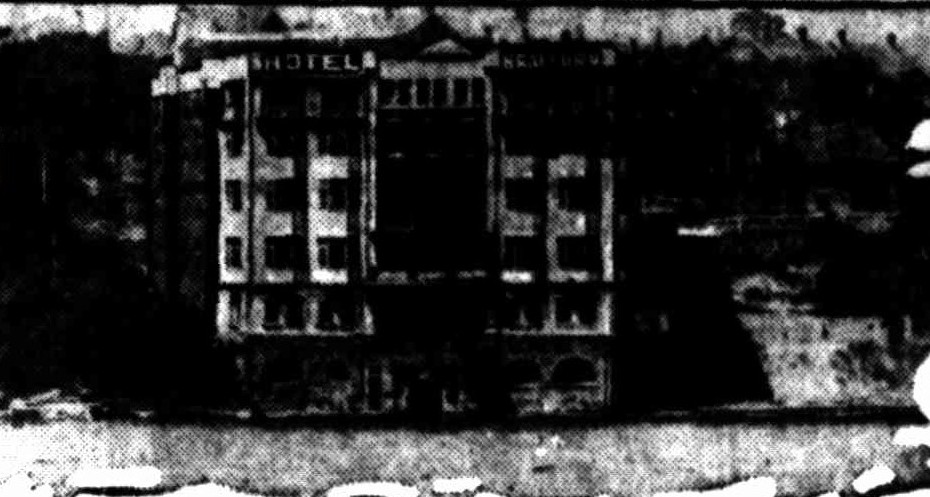
BUILT BY HELENE, COUNTESS MORNER, and standing as a monument to one of the most interesting women Australia has known, the Hotel Braeburn has long been a landmark on Kirribilli Point
Not only did the ensuing few years definitely establish her as a social and fashion leader, but her mammoth speculations were beginning to arouse the envy of many even in her own set. It is recorded that on one occasion in the last decade she prevented a financial crisis in Chile by her historic bulling of 'Caga' bonds — a purely speculative venture which aroused the admiration of many big financiers who at the time little dreamed that the market was being moved by a woman. Perhaps it was the tragedy of her life which drove her to seek such an outlet for her genius. She was a poignant and vivid study in the paradoxes of life. High though her title, proud her name, boundless her wealth as wish could claim, she still was the saddest and the weariest of women. In the midst of the adulation and public curiosity which beset her path at every turn, she still was heart hungry for the real human love and companionship that Fate denied her. That she had not one friend nor love in the world was a confession she made frequently to her intimates during her last few years. Mary Helene passed from safe Investments to daring speculations after that little flutter. She appears to have concluded that to buy anything but money was beneath the dignity of operators like herself. From then on the Governments of the Western world watched her movements with interest, particularly when she arrived in their territories on business. Her operations in French francs in the years immediately following the armistice were something that the money-changers of Europe will long and often unpleasantly remember.
One other thing she bought that might be mentioned was Scotland Island, off Barrenjoey. She was probably the only Australian woman ever to own an island. These were her very big years, 1910-1920. During them she divorced her Count, and contracted a third marriage, this time with another titled gentleman, the Marquis de Ruvigny, a French noble whom she met In the U.S.A.
When she last visited Sydney, the year before her death, the Marquis was not with her. He died a week after her decease, without having enjoyed his share of her huge fortune. This passed to his son, the present Marquis, whose title goes back to way beyond the middle ages, merely taking In Frederic I., surnamed Barbarossa, Holy Roman (German), Emperor of the West, King of Germany and Italy, Duke of Euabla and Alsace, etc. etc., through whole pages and pages of grand titles. The first charge against the enormous estate left by the Countess was £10,000 as a marriage dowry for Felicite. She left a third of her fortune to each of three people. To a beautiful little girl, in her 'teens, and called in her will, Felicite, Daughter of Helene, Countess Morner, and now a young woman roaming at-road as did her restless mother— last heard of at Gibraltar. To the Marquis, and to her stepdaughter, Mab McLachlan. The wanderlust took the Marquise de Ruvigny from Sydney In July, 1920, when she passed Westward bound through Sydney Heads on the old 'Port Elliott.' But the golden landscapes of the English autumn were not for her this trip. She died suddenly off South Africa, and was buried at sea.
Thus passed the remarkable and almost legendary woman to her last and greatest journey. Mary Helene, governess-Marquise, wandered no longer across the deep to which her mortal remains were committed after the skipper 'had read it through,' but the great flat building still towers about Sydney harbor, a monument to her courage and enterprise. After her death the building was bequeathed to the daughter whose trustee was Mrs. Mab McLachlan, wife of a General of the British army of occupation on the Rhine. The name is well known in Sydney high society. Under the new name of the 'Astoria,' the property was sold to real estate specialist Myerson two years ago. Even now, while sea gulls whimper querulously at the windows through which none but curious intruder peep, and while the emboldened cockroach hold high revel in the deserted cellars, mayhap, for all we know, the spirit of Mary Helene returns to visit the ruins of her first great adventure. AUSTRALIA'S MYSTERIOUS WOMAN OF DESTINY. (1930, November 16). Truth (Sydney, NSW : 1894 - 1954), p. 15. Retrieved from http://nla.gov.au/nla.news-article169384957
For more visit: The Tasmanian Countess And Marquise Of Scotland Island
In 1906 the island was subdivided, and 121 lots were advertised for sale – and offered again in 1911.
SCOTLAND ISLAND. — Hardie and Gorman, on Saturday, November 10, will offer 100 water frontage blocks on Scotland Island. Pittwater, near Manly. The terms are 10 per cent., the balance over ten years. Plans are available. COMING SALES. (1906, October 28). Sunday Times (Sydney, NSW : 1895 - 1930), p. 2. Retrieved from http://nla.gov.au/nla.news-article126557176
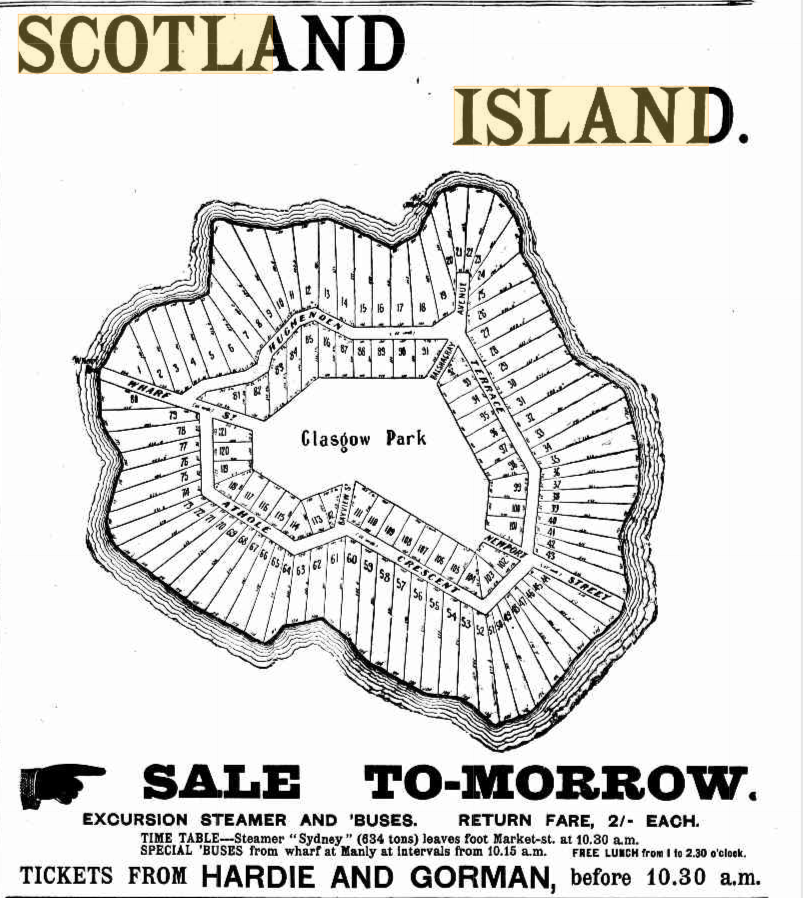
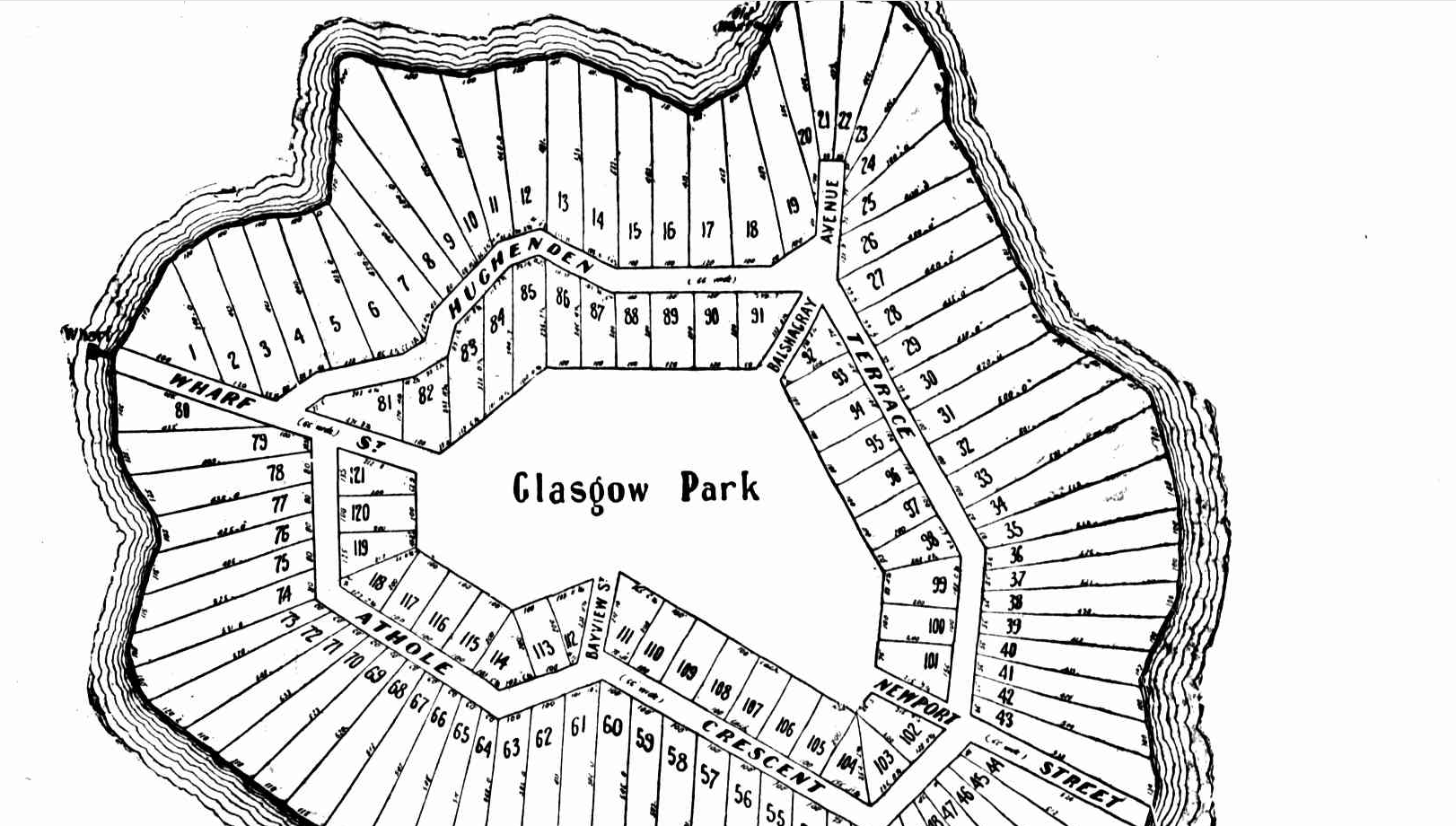
Advertising (1906, November 9). The Australian Star (Sydney, NSW : 1887 - 1909), p. 7. Retrieved from http://nla.gov.au/nla.news-article228493268
Balsnacray: Balshagray Avenue (?) Glasgow
Hughenden: Hughenden is a town and locality in the Shire of Flinders, Queensland. The region in the vicinity of Hughenden was originally known as Mokana in the Yirandhali language. British occupation began in October 1861 with the expedition group led by Frederick Walker camping near the site of the future township of Hughenden. Pastoralists soon followed and in 1863 Ernest Henry and his cousin Robert Gray established the Hughenden sheep station. Hughenden was named after Hughenden Manor in Buckinghamshire, England, the home of former British Prime Minister Benjamin Disraeli. Robert Gray and Ernest Henry both had a family connection with Hughenden Manor. Mary Francis Norris, the daughter of John Norris of Hughenden Manor was Henry's mother and Robert's aunt.
Athole Crescent: Atholl or Athole (Scottish Gaelic: Athall; Old Gaelic Athfhotla) is a large historical division in the Scottish Highlands, bordering (in anti-clockwise order, from Northeast) Marr, Badenoch, Lochaber, Breadalbane, Strathearn, Perth, and Gowrie. Today it forms the northern part of Perth and Kinross, Scotland. In Scottish Gaelic the name is Athall, which derives from the Old Irish Ath-fhotla, or 'New Ireland' (Fotla being a traditional name for Ireland). This is thought to derive from the period of Gaelic settlement of Scotland, which was previously inhabited by the Picts. [3.]
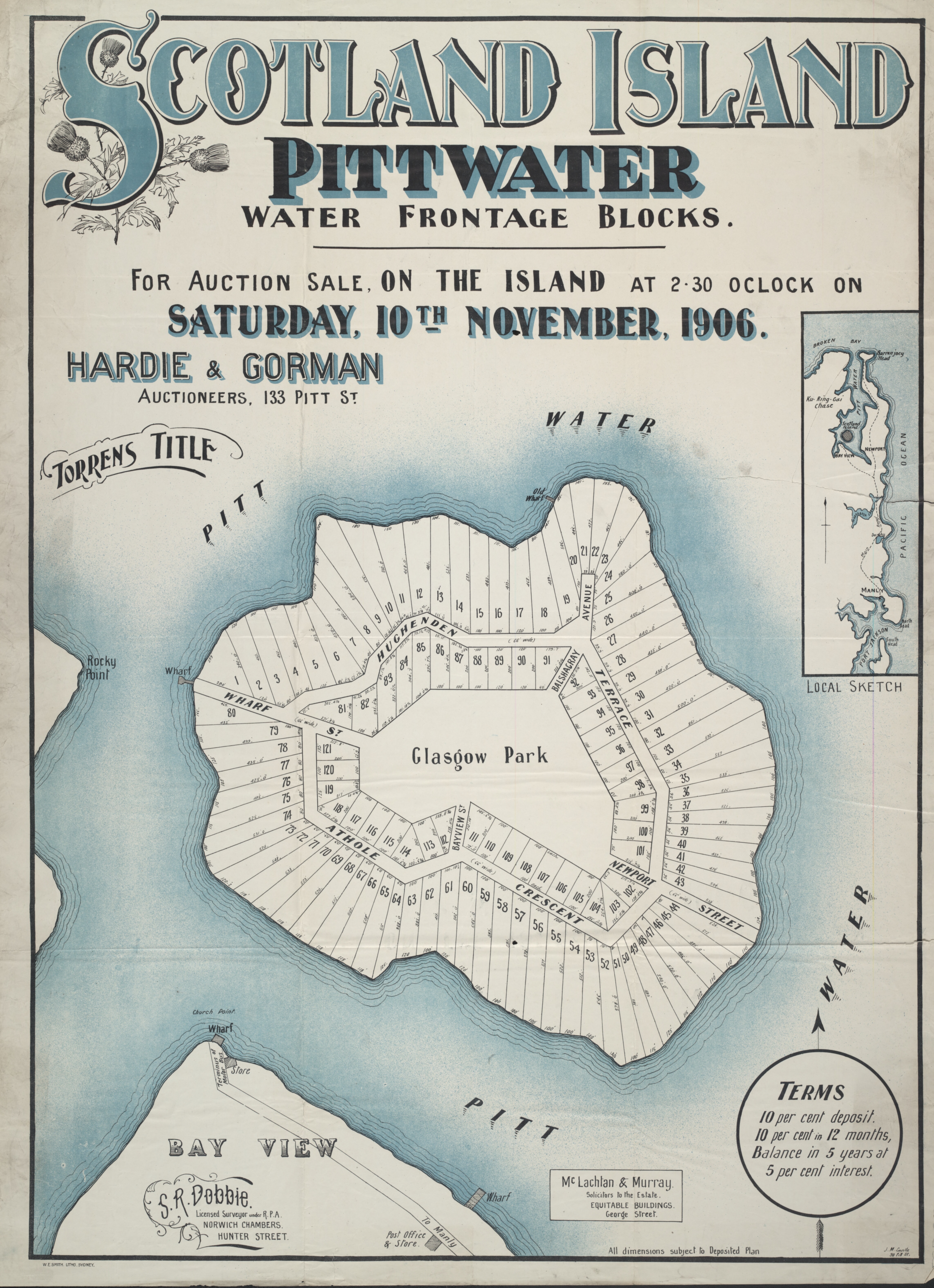
Hardie & Gorman Pty. Ltd & Cantle, J. M & Dobbie, S. R & Smith, W. E. (1906). Scotland Island, Pittwater water frontage blocks Retrieved from http://nla.gov.au/nla.obj-230480849
NB on Lithograph: The Graziers' Association's solicitors, McLachlan and Murray - these were also Mary Helen's solicitors.
Messrs. Hardie and Gorman announce by advertisement particulars concerning the sale In- auction of Scotland Island, near Pittwater. The vendors' point out that the island is well adapted to residential purposes, that the soil is good, and that the subdivision has be in so arranged as to give a great depth to every purchase of a water frontage. Moreover, provision will be made for children and families on portion of the water frontage which can be used for general recreation purposes. The vendors further point out that the present motor bus service between Manly and Pittwater may eventually be replaced by an electric tram service. THE COMMONWEALTH. (1906, November 3). The Sydney Morning Herald (NSW : 1842 - 1954), p. 13. Retrieved from http://nla.gov.au/nla.news-article28154613
PROPERTY SALES. Messrs. Hardie and Gorman held a sale of Scotland Island Pittwater (in subdivision), on the Island on Saturday afternoon last. Several blocks were sold at from 20s to 25s per foot on the water frontages. It is proposed to hold a continuation sale of the remaining portions in the salerooms, 133 Pitt-street, on Wednesday next, for the convenience of those persons who could not attend the sale on Saturday last. PROPERTY SALES. (1906, November 16). The Sydney Morning Herald(NSW : 1842 - 1954), p. 9. Retrieved from http://nla.gov.au/nla.news-article14806836
Subdivision of Scotland Island . Week-end Residences or Marine Homes.
The famous Scotland Island at the mouth of the Hawkesbury, a spot which the Government should never have sold, but preserved as a marine park, has now been subdivided and is for auction sale on Saturday, November 25, the auctioneers being Messrs. Stanton and Son, Pitt-street. This auction sale affords people an opportunity of securing a unique restful home in one of the most charming marine spots in Australia. For a century this has been the locality of fishing and marine excursions, and scores of times efforts were made to secure the purchase of the Island from the Government; but, as has already been announced, private success in this direction was only recently effected. When it was known that, so charming and isolated a marine spot as Scotland Island had been secured in private purchase, great efforts were made to induce the Government to resume possession; but it was decided not to disturb the people who had now become the owners. I ro'ii all this, the value of Scotland Island will be fairly well estimated, and it is satisfactory to find that a very liberal plan of subdivision has been decided on, ensuring the creation of many seaside homes in this delightful quarter. No doubt weekend residences on the bungalow line will prove a big boom to Sydney business men and other- who desire a change, or who need to recuperate, and certainly the terms of sale will facilitate the purchases. Subdivision of Scotland Island. (1911, November 11). The Newsletter: an Australian Paper for Australian People (Sydney, NSW : 1900 - 1918), p. 3. Retrieved from http://nla.gov.au/nla.news-article102805326
Scotland Island. The Manly-Pittwater tram will very shortly now be opened to Narrabeen, and those desirous of securing week-end blocks in the delightful neighborhood of Pittwater will have an opportunity on Saturday next of bidding for the water frontages of one of the most unique positions on the coast. As Garden Island in Sydney Harbor, so is the historic Scotland Island to the Pittwater Lake. There is no doubt this beautiful island, which surely-should have been purchased by the Government, will, in this aristocratic quarter of the district, and those purchasing now will reap the benefit as soon as the tram opens. The areas are big, and so as to give the purchasers a real residential picnic block worth having, the averages being 100ft. frontage to deep water with a depth of 600ft. A special steamer leaves Gosford Wharf on Saturday and motor buses leave Manly in time for the sale at special excursion return rates. Tickets are printable from Messrs. Stanton and Son, the auctioneers, Pitt-street. Scotland Island. (1911, November 25). The Newsletter: an Australian Paper for Australian People (Sydney, NSW : 1900 - 1918), p. 9. Retrieved from http://nla.gov.au/nla.news-article102802821
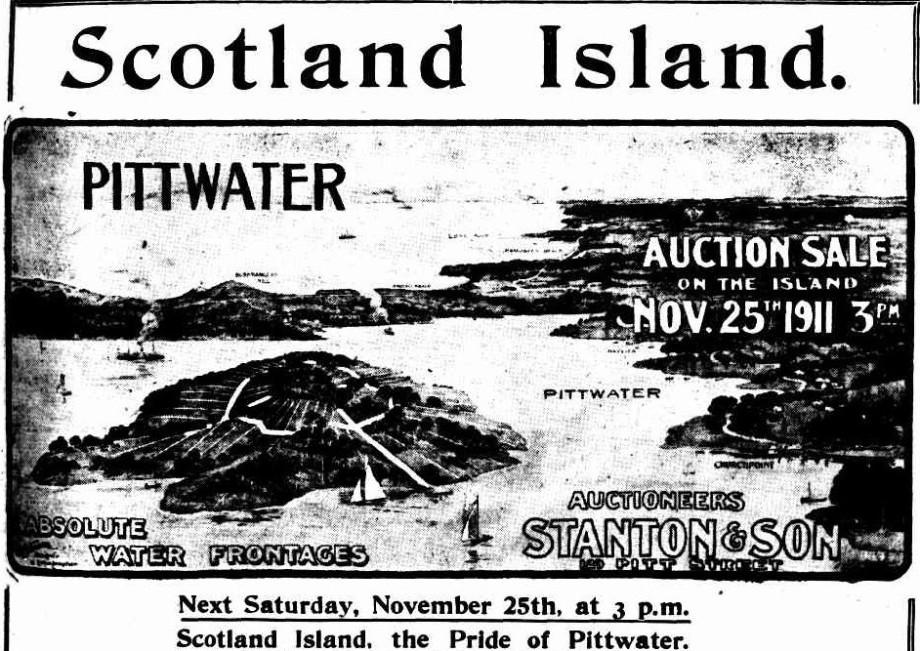
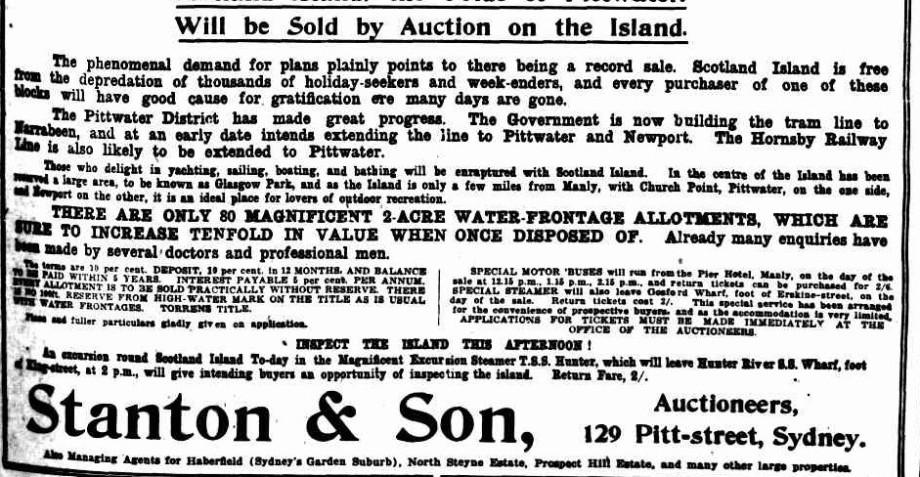
Judging by the tickets that have been sold, there will be a rush this afternoon for Scotland Island in the famous Pittwater district. The Island has been subdivided into 80 magnificent two-acre water frontage allotments, and these are to be sold by Messrs. Stanton and Son. Intending buyers have the choice of two routes to the sale to-day. Special motor 'buses are to run from the wharf at Manly, but for those who desire a sea trip a steamer will leave the foot of Erskine-street in time for the sale. In the centre of the island an area has been reserved to be known as Glasgow Park. REAL ESTATE. (1911, November 25). The Sydney Morning Herald (NSW : 1842 - 1954), p. 13. Retrieved from http://nla.gov.au/nla.news-article15291764
TENDERS are hereby invited for the Formation of about 120 chains of Pathway on Scotland Island, Pittwater. TENDERS CLOSE noon SATURDAY, 12th January, 1024. Plans and specifications may be inspected at the offices of HARDY, BUSBY, and NORMAN, Licensed Surveyors and Civil Engineers,175 George-street. city. Advertising. (1912, March 20). The Sydney Morning Herald(NSW : 1842 - 1954), p. 15. Retrieved from http://nla.gov.au/nla.news-article15318639
ON SCOTLAND ISLAND, PITTWATER.
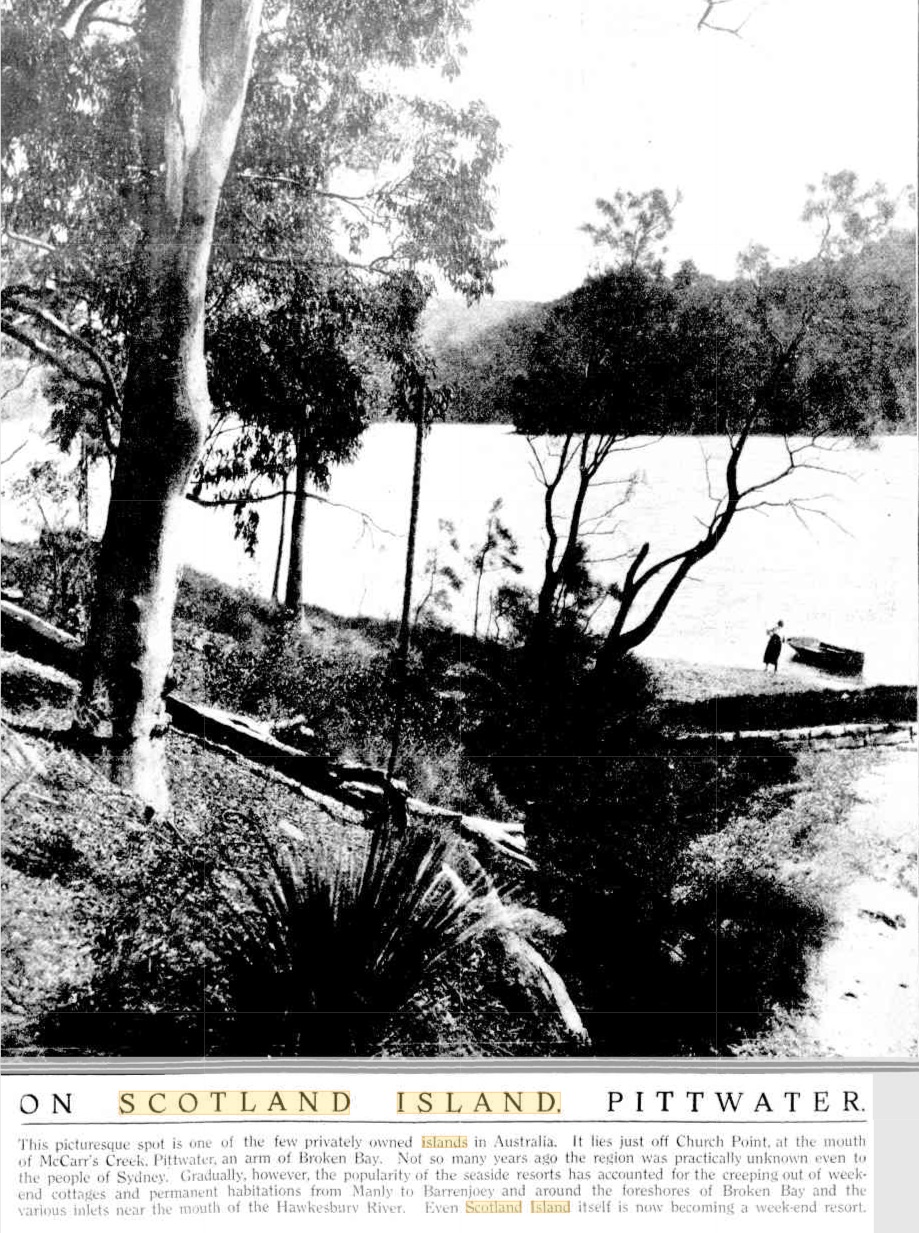
This picturesque spot is one of the few privately owned islands in Australia. It lies just off Church Point, at the mouth of McCarr's Creek, Pittwater, an arm of Broken Bay. Not so many years ago the region was practically unknown even to the people of Sydney. Gradually, however, the popularity of the seaside resorts has accounted for the creeping out of weekend cottages and permanent habitations from Manly to Barrenjoey and around the foreshores of Broken Bay and the various inlets near the mouth of the Hawkesbury River. Even Scotland Island itself is now becoming a week-end resort. ON SCOTLAND ISLAND, PITTWATER. (1920, April 21). Sydney Mail (NSW : 1912 - 1938), p. 5. Retrieved from http://nla.gov.au/nla.news-article159028427
(Before the Chief Judge, Mr. Justice Street.)
SCOTLAND ISLAND ALLOTMENTS.
Peek v Union Trustee Company of Australia, Limited.
Reserved Judgment was delivered in the suit In which the plaintiff, Rupert de Lacey Peek; asked, among other things, for a declaration that a certain agreement, which was subsequently modified, with respect to the sale of a number of allotments of land on Scotland Island, near Pittwater, ought to be specifically performed and carried into execution by the defendants, the Union Trustee Company of Australia, Ltd., and that the same be decreed accordingly.
Plaintiff claimed that on December 30, 1921, at the instance of Gwendoline Mab McLachlan, executrix of the will of the late Mary Helen de Massue, Marquise de Ruvigny, the defendants were appointed her attorneys for the purpose of obtaining letters of administration with the will annexed of the estate of the deceased. One of the assets in the estate consisted of a number of unsold allotments of land at Scotland Island. Messrs. McDonald and Watson, It was alleged, were the appointed agents for the purpose of the sale of the allotments. On September 6, 1922, McDonald and Watson wrote to the plaintiff, advising him that they had asked the defendants for an option In his name to purchase the allotments for £5000, on certain terms; and that the defendants had informed them that they were willing to dispose of the whole of the unsold portion of Scotland Island to him for £5250, on certain terms, including a cash deposit of £1000. On September 18 he paid to the defendants a preliminary deposit of £10 In connection with the purchase, for which he obtained a receipt. Subsequently the contract was modified in certain respects. He had always been ready and willing, and hereby offered to perform the agreement In all respects, but the defendants had repudiated it, and refused and neglected to perform it. Plaintiff also asked that In addition to, or in lieu of, specific performance of the agreement be modified, the defendants be ordered to pay him the damages he had sustained by reason of their refusal to perform the contract; and that the defendants be restrained by injunction from selling, mortgaging, or otherwise dealing with the lands, except under his direction.
The defendants denied that McDonald and Watson were their agents In the matter of the sale; and that the agreement was as alleged In the statement of claim- They asserted that the plaintiff did not pay the deposit within the time fixed by the agreement as mutually varied by him and them, where-upon they rescinded the contract, to which the plaintiff acquiesced. ' After the recession of the contract (If any) and the plaintiff's acquiescence In the same, they re-sold the allotments. They submitted that in the circumstances mentioned the plaintiff was not now entitled to a decree for specific performance of the agreement. Neither the contract alleged in the statement of claim as having been originally made, nor as A-arlod, was In writing, and there was no written memorandum signed by them or anyone lawfully authorised by them to do so; and they submitted that the suit should be dismissed with costs. By way of counter claim the defendants pleaded that the plaintiff had filed a caveat forbidding any dealings with the lands. They were desirous of applying to have the lands transferred to them as administrators of the estate of the deceased, and so transferring the properties to purchasers from them. They asked that the plaintiff's caveat be rescinded, and that he be ordered to pay the costs of the counter-claim.
His Honor, after reviewing the facts, said it was clear that as the company broke off negotiations before it signed the formal document, there was no existing contract enforceable against it, and it was not really material to consider whether it acted reasonably or unreasonably in doing so. He thought, however, that the company had acted justifiably and reasonably in breaking off negotiations. It was obvious that the plaintiff was never in a position to carry out his purchase, and that his tactics all through really amounted to an endeavour to obtain what was in substance an option of purchase while he looked round to try and find someone to finance him in the matter. The company showed him a considerable amount of indulgence, but, in the position in which it stood, it could not allow that state of affairs to continue indefinitely, and his Honor thought that it was Justified In calling a halt when it did. He thought, therefore, that the suit failed, and must be dismissed, with costs. The counter claim, which asked that a caveat against dealings lodged by the plaintiff might be removed, would be allowed, with costs.
Mr. E. F. McDonald (instructed by Messrs. A. E. Whatmore and Lee) appeared for the plaintiff; and Mr. Maughan, K.C., and Mr. R. K. Manning (instructed by Messrs. Priddle and Gosling) represented the defendants. IN EQUITY. (1923, December 8). The Sydney Morning Herald(NSW : 1842 - 1954), p. 13. Retrieved from http://nla.gov.au/nla.news-article16124649
Warrinah Shire Council Minutes of Meetings:
24th June, 1924 . Scotland Island Estate Ltd. stating that they bought only unsold allotments an the original Scotland Island subdivision and have no title to the park on the upper part. Resolved: (Crs. McKillop, Campbell) That the Council's Solicitors be instructed to take the necessary steps to have the park on the upper part of Scotland Island dedicated and that final approval to the plan be deferred until such dedication is effected.
7th of July 1924: 15. Union Trustee Co. of Australia Ltd. 30/6/24. Agents for the Estate Marquise de Ruvigny, Deceased, stating they are prepared to execute any necessary document for the dedication of the Park on Scotland Island - Resolved, - (Crs. • Rayner, Hewitt) That the Seal of the Council be affixed to the Deposited plan of Scotland Island Estate, immediately 7) the Shire Solicitor advise there will be no further hindrance to the transfer going through, and the Solicitors be asked to expedite the matter. . 16. Hardy, Busby and Norman (2/7/24) stating that the wharves and pathways on Scotland Island are almost completed, and asking that an early inspection c made, (Dealt with earlier in the meeting,) Scotland Island in Pittwater.
With the 1921 death of Marquise of Scotland Island, and the sorting out of the legal matter published by the SMH above, the island itself came under the stewardship of Herbert James Fitzpatrick, one time owner of the classic yacht Bona and originator of the Scotland Island Yacht Race.
His first subdivision into 361 lots in 1924 appears as;
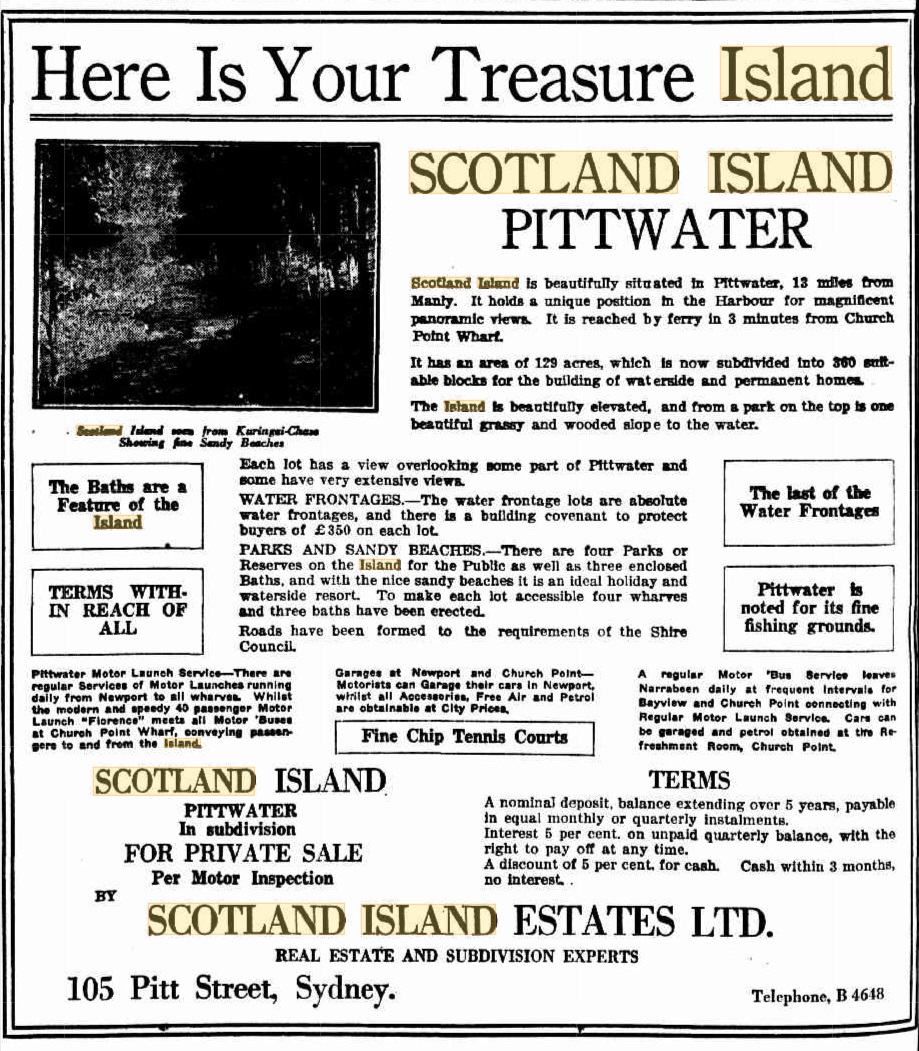
Advertising (1924, October 18). Smith's Weekly (Sydney, NSW : 1919 - 1950), p. 20. Retrieved from http://nla.gov.au/nla.news-article234428316
Alike the family of Mary, Marquise of Scotland Island, Mr. Fitzpatrick and Mr. Robertson were focused on giving back, not just profiting - from Warringah Shire Council Minutes of Meetings:
Hardy, Busby &Norman, re Scotland Island Subdivision and stating proposal to construct a pathway in Elvina crescent - - and a Tennis Court in Catherine Park : Resolved, - (Crs.Hewitt Campbell)'That the Council approve of the proposal. - - 13. Same. 24/3/24, re same estate, -and stating proposed to substitute sawn turpentine sheeting for galvanised wire mesh in baths to be constructed : Resolved, 8212; (Crs. Hewitt, Campbell) That the Council approve;
April 14th, 1924 Crs. Hitchcock, Hewitt) That in consideration of further work done, of the guarantee lodged in respect of Scotland Island Subdivision, be refunded. Hardy, Busby and Gorman 4/6/24, submitting Deposited Plan of Scotland Island Estate for affixing of. Council's Seal and also Memorandum of Dedication of portion of original Lot 7 of Scotland Island as on extension of the circular road . Resolved, - (Crs. Hewitt, Hitchcock) That the Council accept dedication for the purposes of the public highway, of the piece of land edged red on the plan annexed to the Memorandum of Dedication by D G Robertson
The story of the naming of the byways around the island via his family traditions is best told by his own daughter:
Surprise! Surprise!
By Elvina Holmes (Nee Fitzpatrick)
When it was announced at a recent Mass for catechists that Father Carol Grew was present on the altar, and that he came from the Diocese of Broken Bay, I made myself known to him. He was surprised to learn that he was talking to a person called Elvina, and when he asked me if I could write an article in his parish magazine, I too got a surprise.
I have been deciding how I would write this article and decided I would start at the very beginning.
An aunt called Mrs. Elvina Noonan, who lived at Manly, was very ill in hospital and this is where her sister, Florence, who lived at Randwick, was visiting her and met up with Elvina’s friend and neighbour. His name was Herbert. Elvina died on 1st July, 1922 and Herbert and Florence were married at Randwick in December 1923.
Herbert Fitzpatrick had just bought Scotland Island and this is where they spent their honeymoon, in a very small fibro cottage.
It was at this time that all the streets on the Island were named after members of both families (with the exception of Thompson street and Robertson road) and as Herbert prospered and developed areas around Pittwater, Newport and Avalon,more streets and parks were named after members of the families. It is no wonder he named Elvina Bay after the lady who had been responsible for he meeting his wife.
Frank was the first born and when I arrived 12 months later I also was named Elvina. We were both born at Manly in the Crescent Hospital under the medical care of Dr. Moncrieff Baron, who was the medico for dad’s family at Manly. Dr. Baron and Dr. Drummond went on to found the Far West Home. We were living at Clifton gardens at this time but came to Manly to live about 7 years later.
There were two ferries operating from Church Point, one called “Florence”, the other “Elvina”. We had a holiday home over at Lovett’s Bay called “Elvina Lodge” and this is where many happy years were spent growing up. Two other brothers were born, Herbert Anthony (Called Tony) and the youngest named Geoff. He has a daughter named Elvina (the third)!
When we were at “Elvina Lodge” we used to count the number of houses being built on Scotland Island, which were very few. A niece who lived with us (actually her mother was Elvina the first) used to tell us about Scotland Island, and all the yarns about a treasure being hidden there.
There was no electricity in those days, but we did have a telephone and a Mr. Whymark* from the Church Point store would bring supplies over to us. There was a man named Mr. Hall who lived in Towlers Bay who used to bring us down goats milk and apart from his house and another little shed built over the water near our house, there were no other houses on our side of Lovett’s Bay. In this little shed lived a Mr. Bill Besser and we would visit him and see sometimes water lapping up through the floor boards. He taught us to swim and dive in our baths and we heard when war broke out he was interned being a German.
For quite a few years the Redemption Fathers and students from Pennant Hills would wend their way down to “Elvina Lodge” for their month’s annual holidays. They would pitch tents and have a great time with the launch “Elvina” and dad’s yacht “Bona”.
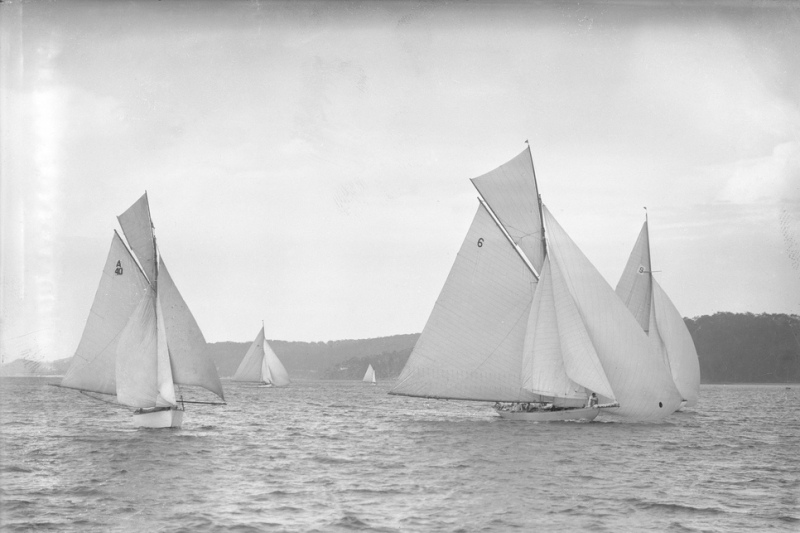
Pittwater Regatta - The vessel RAWHITI appears at the centre of this image with the number '6' on the mainsail. To the left is CUTTY SARK, displaying the text 'A 40' and the vessel to the far right with the number '19' on the mainsail is BONA, Image No: 11538, courtesy Australian National Maritime Musuem.
There were just so many Masses said during these holidays, that when the house was burnt down by bush fires around 1936, we all wondered why. I must mention that the Redemptorists would come on this holiday complete with their cow, and if they could find a track down from West Head, perhaps in future years a road may be built to open up this beautiful area.
Wealth isn’t permanent and dad lost most of his wealth, but his dream was always the development of Pittwater. He would say the views between Manly and Palm Beach and Pittwater were the best in the world.
My father died in 1938 (Dr. Baron signed the death certificate) aged 48. Two years later we moved from Manly.
It wasn’t until 1983 that I first set foot on Scotland Island.
I had recently been to Pittwater, caught the ferry over to our old wharf (now named Hall’s Wharf), walked along Bona Avenue and up to where this Mr. Hall used to live. The house is now a Youth Hostel and the frangipani trees weer still there. We used to play under these trees and gather up the blooms. When word got around that I was connected with the area, the Council invited us to the Community Hall on Scotland Island. This was a step in the right direction and I couldn’t believe my eyes to see how populated the area was.
The old ferry “Elvina” still in operation seems to me to be the original one, it looks so old.
Dad found no treasure on Scotland Island. I think the treasure is Scotland Island itself.
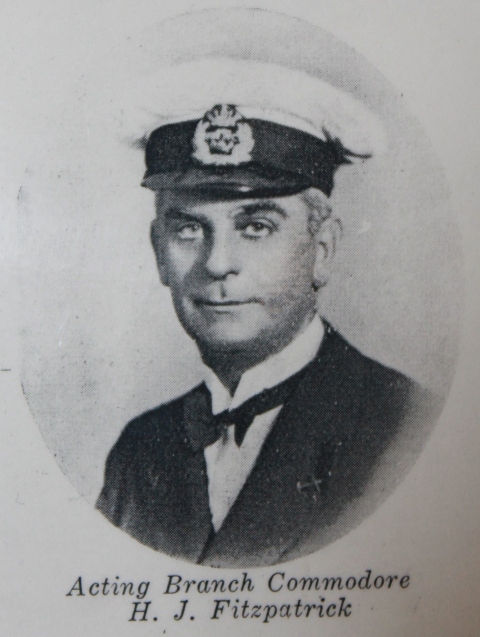
Business Change.— Mr. H. J. Fitzpatrick has disposed of his furniture emporium to Mr. J W. Baker, of Sydney, and he and Mrs. Fitzpatrick, and Miss Pat Noonan, propose leaving Narandera early next week. They have resided here for about 12months and during that time have made a large number of friends, who will regret their departure. On account of having pastoral property in the Armidale district, Mr. Fitzpatrick was only able to devote part of his time to his Narandera business. He nevertheless interested himself in local affairs, including the swimming club, of which he was president. Mrs. Fitzpatrick and Miss Noonan (her sister) have interested themselves in the work of St. Mel's Church. Local and General. (1936, February 14). Narandera Argus and Riverina Advertiser (NSW : 1893 - 1953), p. 2. Retrieved from http://nla.gov.au/nla.news-article100800573
Farewell to Mrs. H. J. Fitzpatrick and Miss Pat Noonan. The high esteem in which Mrs. H. J. Fitzpatrick and her niece, Miss Pat Noonan, were held during their stay of about 12 months in Narandera were shown to them on Thursday evening last, when about 40 friends gathered at their home and gave them a surprise farewell party. ... A very dainty supper was served by the ladies, after which the Rev. Father Bongiorno made presentations to the guests, end he spoke In high esteem of them. Mrs. Fitzpatrick was presented with a pair of cut glass perfume bottles and Miss Noonan with a cut glass powder bowl. Mr. Fitzpatrick suitably responded, on behalf of his wife: and niece, and thanked the Rev. Father Bongiorno for 'his kindly remarks, and their friends for the beautiful presents, he said they were very sorry to leave such a lot of good friends, and it would not take gifts to remind them 'of the many friends they had made in Narandera. 'For They are Jolly Good Fellows' was sung with great enthusiasm, and the Ringing of 'Auld Lang Syne' brought to a close a very happy function. Mr and Mrs. Fitzpatrick will leave for Sydney today (Tuesday) and they intend to reside at Manly. Farewell to Mrs. H. J. Fitzpatrick and Miss Pat Noonan. (1936, February 18). Narandera Argus and Riverina Advertiser (NSW : 1893 - 1953), p. 2. Retrieved from http://nla.gov.au/nla.news-article100811795
Elvina Holmes, daughter of the past owners of Scotland Island, and her daughter Jennifer, along with her husband Reg, were honoured guests at the opening of the new Scotland Island Community Hall on July 17, by the President of Warringah shire, Cnr. Paul Couvret.
Florence Terrace was named after her mother Florence Fitzpatrick, Kevin street after uncle Charlie Kevin, Vivian street after Uncle Vivian (her mother’s brother) and Elsie street after another aunt. Harold street came from yet another uncle and Richard road was named after her maternal grandfather, while Catherine Park was named after her maternal grandmother and Elizabeth Park was named after H.J.’s mother.
Loranna street was named after a launch, as was Florence, another launch.
Robertson road was named after D.G. Robertson, and so was Robertson Bay where Yamba now stands.
KALLAWATTA, LIMITED.
This firm made its first start on the 1st January, 1907, under the name of Laughton Bros., trading up the Hawkesbury River and along the coast of New South Wales, north to Port Stephens and south to Shoalhaven for about two years, but since then has confined its trade to the Hawkesbury only.
In 1913 the business was floated into a limited liability company, under the title of the Kallawatta Ltd., when a new boiler and machinery were imported from Clyde Bank and extensive alterations were made in the hull and fittings to strengthen and improve the vessel bringing it up to date as a cargo carrier. Besides the steamer Kallawatta the company has four droghers owned or subsidised on the Hawkesbury to convey cargo to and from the tributaries of the main stream. The steamer makes two trips a week from Sydney to Hawkesbury and back. The directors of the -company are Messrs. James Laughton and J. S. Laughton, while Mr. L. M. Brier-Mills has been manager during the- whole of the firm's existence. The late Captain J. W. Laughton was in command of the steamer for several years, and was succeeded by his brother, Captain James Laughton. At Hawkesbury railway station, 36 miles from Sydney, the railway crosses the river by a magnificent bridge, which is the longest in Australia. It spans the waters from Long Island to the northern shore. Its total 'length is 3,000 feet. The scenery is generally considered to be as fine as anything in any other part of the world. Anthony Trollope, who visited the colonies some years ago, wrote of it: 'Govett's Leap astonished me very much, but not, I think, so much as the scenery of the Hawkesbury River ? There may be special points in other streams which' have endeared themselves to the world — such especially as the Falls of Niagara— such as the Inn at Innspruck — or the Rhine at Geneva — or the Upper Lake at Killarney, which is in truth a river; but for continued scenery the Rhine stands first. There is a river, or rather a portion of the river, known to very few tourists, which, I think, beats the Rhine: This is the Upper Mississippi, for about 150 miles below St. Paul. It is not my business here to describe the Mississippi; but I mention it with the object of saying that in my opinion the Hawkesbury beats the Mississippi. I should not fake the contrast unless there were many features in the two which are similar ?
At all of them the banks rise suddenly, sometimes covered with timber and sometimes bald — sometimes sloping and sometimes precipitous — but at all of them the banks are broken here and there into lateral valleys, which give to the imagination the idea that the glory of the scene is far spread, and would repay pursuit. Unless it can convey this vague feeling of distant, unapproachable and almost mysterious delight, scenery loses half its charms. On the Rhine, on the Mississippi, and on the Hawkesbury alike, there is created an idea that if the traveller would only leave the boat and wander inland, he would be repaid by the revelation of marvellous beauties of Nature — beau-ties which have, perhaps, never yet met the eyes of man. The lower part of the river — that between Wiseman's Ferry and Pittwater, which is a large inlet of the sea running southward from Broken Bay — is very much finer than the upper reaches. The Rhine has its castles and its islands, and it has too, in its favour the bright color of its waters. The Upper Mississippi has no castles, nor are its waters bright; but it has islands, and innumerable bluffs and ehadlands, and varied valleys, and park-like timber, and its own fast-running rush of waters, which are to me more than compensation for castles and the color.
The Hawkesbury has neither castles nor islands, nor has it bright, clear waters like the Rhine; but the headlands are higher, and the bluffs are bolder, and the turns and manoeuvres of the course which the waters have made for themselves are grander, and, to me, more enchanting than those of either the European or American river.' Combination rail and steamer trips are run throughout summer.
The beautiful river and grand scenery and health giving charm of Pittwater should be better known and oftener visited by city dwellers. Accommodation can be obtained at Mrs. Greig's, Newport Hotel, equal to any metropolitan house. Comfortable and cool rooms, good cooking, spacious grounds and visitors can avail themselves of the enclosed sea baths or indulge in surf-bathing. The hotel is only 12 miles from Manly and can be reached by tram, but nothing can compare with the trip by steamer for scenery.
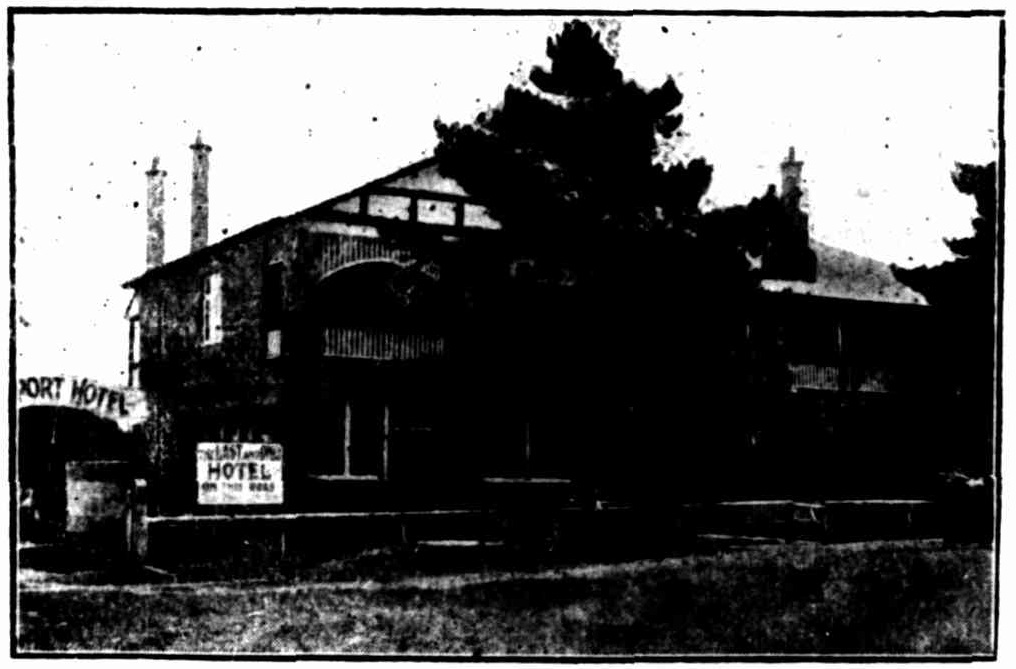
Brooklyn and Palm Beach, where the steamer calls, are also becoming favourably known as tourist resorts, and have excellent boarding houses. The fine residences of Mr. R. N. Dangar, on Dangar's Island, and Mr. Robertson's on Scotland Island, are always objects of interest to the travellers, but the trip must be taken by steamer before anyone can realise the -charm of the varying scenery. The Kallawatta is always well patronised by the residents along the river, and anyone desirous of obtaining information as to sailing dates can apply to Mr. BrienMills, the manager, at the office of Kallawatta' Ltd., foot of Bathurst-st.
KALLAWATTA, LIMITED. (1918, February 5). Daily Commercial News and Shipping List (Sydney, NSW : 1891 - 1954), p. 6. Retrieved from http://nla.gov.au/nla.news-article159389226
The earliest photo of Bangalla dates from a 1920 advertisement according to some sources. By 1917 George Henry Hebden is owner:
MR. G. H. HEBDEN.
DEATH OF NOTED STOCK BREEDER.
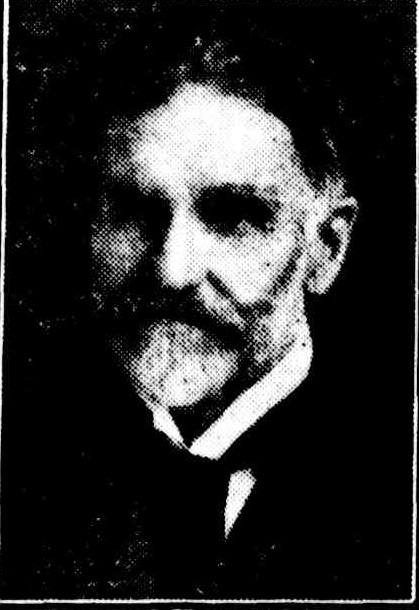
Mr. George Henry Hebden, who was well-known throughout New South Wales as a breeder of Suffolk horses and Romney Marsh sheep, died on Saturday at his residence, Havilah, Darlinghurst, at the age of 76 years. He was the eldest son of the late Mr. George Hebden, of Maharatta, Bombala, and late of Brookong, Urana.
Mr. Hebden was educated at Macquarie Fields, the Melbourne Grammar School, and Repton, England. On leaving school he entered the Bank of Victoria, Melbourne, but after five years his desire for a country life led him to Brookong. Shortly afterwards, Messrs. Hebden and Osborne having disposed of that property, he and his brother Charles took up the management of Gogeldrie, which had been purchased by their father. He remained there after his father's death as man-ager for the Hebden family until the estate was sold. Mr. Hebden then became the owner of Erambie, near Molong. He was also interested, as a partner with his brother Charles, in Welbondongah and Errowanbang.
Some years ago Mr. Hebden came to reside in Sydney, but his interest in country pursuits and love of the sea impelled him to buy a small property near Shellharbour. There and at Scotland Island, Pittwater, he spent many active days.
During the war the late Mr. Hebden took a practical interest in the welfare of the soldiers, and since the end of the war was always ready to assist returned soldiers.
Mr. Hebden leaves a widow, but no children. The funeral will take place this morning at the South Head Cemetery.
MR. G. H. HEBDEN. (1924, September 2). The Sydney Morning Herald (NSW : 1842 - 1954), p. 10. Retrieved from http://nla.gov.au/nla.news-article16168506
Bangalla, stated by many to be the oldest house on the island, is advertised soon after as:
“Scotland Island, Pittwater. In the Estate of the Late G. H Hebden, an absolute waterfrontage property with boatshed, baths and the best jetty in Pittwater. Gentlemans Bungalow known as ‘Bangalla’, commanding extensive views of Newport, Bayview and Islands. Built of stone with attached weatherboard additions, front and rear verandahs, containing 5 bedrooms, living and lounge rooms, kitchen, bathroom, heater, laundry and necessary appointments, workshop and mans room detached. Furniture all in good order can be taken at valuation. Land comprises 2 acres 3 roods 33 perches, Torrens Title”. Advertising (1924, October 25). The Daily Telegraph (Sydney, NSW : 1883 - 1930), p. 7. Retrieved from http://nla.gov.au/nla.news-article245472867
This historic property could be visited as a holiday home until it was sold in 2021. Visit: http://www.bangalla.com.au/index.html
For more visit: The First Scotland Island Cup, Trophy And Race And The Gentleman Who Loved Elvina Bay
For more on Dr. Charles Autry Hall - Visit: The Pittwater YHA: Some History
*Wymark – visit: Frederick Victor Grey Wymark and more about his son Charles Wymark in Pittwater Restaurants You Could Stay At Pasadena Road House – Church Point
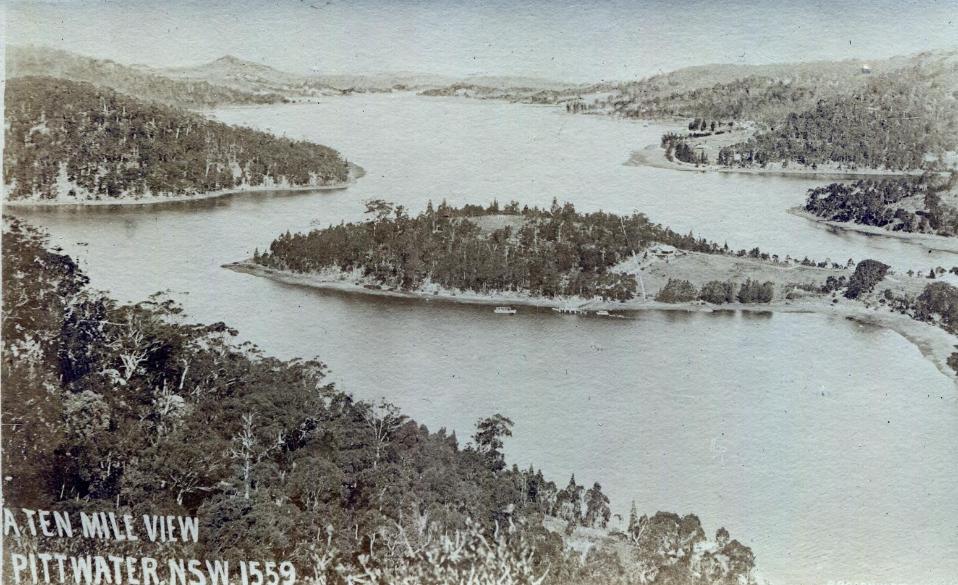
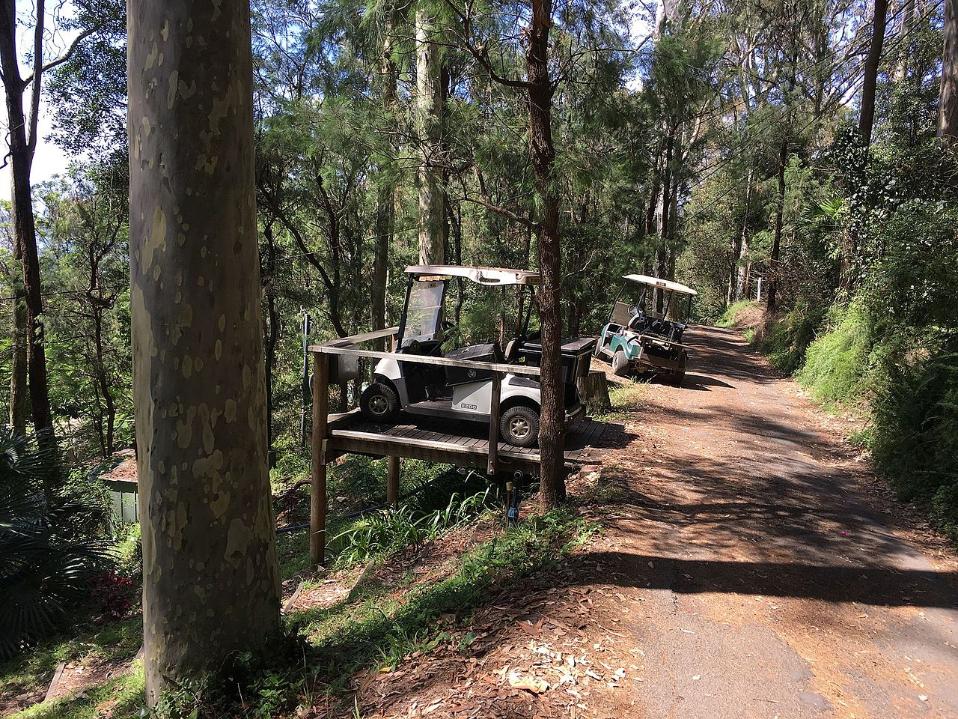
Scotland Island, Pittwater, in 2016 - photo by and courtesy Phil Whitehouse
References And Extras
1. TROVE - National Library of Australia.
2. Sydney’s Suburbs: Scotland Island. Virginia McLeod. 2008.
3. Wikipedia
Electricity came to the island in December 1962. Many of the original wooden poles were replaced during the 1990s, when helicopters lowered cement poles into position.
In 1967 residents voted against a levied permanent town water supply to houses on the island: everyone relies on collecting rainwater. There is no sewerage system. Excess water filtering into the ground is a problem, threatening the Spotted Gums (Eucalyptus maculata), which are a special feature of the Pittwater area.
The community hall is an important venue for a range of activities, including drama performances and residents’ meetings. It was built entirely by volunteer labour and was completed in 1981 after 18 months of work. The local council provided assistance of $28,000 for building materials. The island produces its own newsletter and maintains a strong sense of community into the twenty first century.
From: Sydney Journal 1(2) June 2008. Sydney’s Suburbs: Scotland Island. Virginia McLeod pp 109–110. Sydney Journal is part of the Dictionary of Sydney project www.dictionaryofsydney.org
Early Days of Windsor (By Rev. James. Steele.)
ANDREW THOMPSON.
Amongst the pioneers of Windsor none is so familiar to local residents as Andrew Thompson. He was born in Scotland about the year 1773. His parents were of the poorer class, his father being engaged in a small business. When 16 years of age he was transported to New South Wales for setting fire to a stack of hay, and arrived by the ship "Pitt" in the year 1792.... On arrival, he was appointed to the stone gang at Parramatta, where he probably remained for a few years. We first hear of him at the Hawkesbury early in the year 1800, when the population was very small, as a settler and constable. At a meeting of settlers held to fix the price of stores and labor, at the Hawkesbury in the year 1800, Andrew Thompson was amongst those present, also D. Smallwood Edward Robinson, and M. Lock.
On 1st July, 1803, he obtained a grant of 120 acres from Governor King, on the South Creek, opposite the property now occupied by Mr. John Tebbutt, extending out to Mcgrath's Hill. On 11th August, 1804, he also got another grant of 270 acres adjoining Nelson' Common, afterwards known as Killarney, where subsequently the Scarvell family resided for many years. In the year 1802 he built the first bridge over the South Creek. It was a floating bridge, and was situated about 100 yards farther down the creek than the present bridge behind the Court House. Towards the construction of this bridge he got a Government grant of £15, and was also supplied with Government labor. Permission was given him to collect toll, and he was guaranteed against opposition. In 1806 this structure was replaced by a log bridge, for which he got a 14 years lease.
On 13th November, 1800. Governor King issued a proclamation that in order to prevent litigation, all agreements for the Hawkesbury should be registered with Andrew Thompson, the registration fee to be 6d each entry. About this time he was also appointed superintendent of labor gangs. He also turned his attention to shipbuilding for we find in returns dated 28th, February 1804, and 27th December, 1805, that he was the owner of the following vessels, trading to Bass Straits and Sydney: "Nancy," 20 tons; "Hope," 16 tons;, and "Hawkesbury.'' 15 tons. They were registered in October, 1802, and March, 1804, and carried crews of three to six men each. From other sources we learn that these vessels were built on the Hawkesbury. He also built the "Governor Bligh," in 1807, which traded to New Zealand.
Andrew Thompson appears to have had some literary taste for in an advertisement in "Sydney Gazette", 9th December 1804 he asked that those to whom he had loaned certain books would kindly return them. The list of missing books is given, which includes such standard works as Milton, Burns, Sterne, Thomson, Hervey, and others.
A Government order, dated 8th April, 1804, ordered that all boats trading on the Hawkesbury River should be numbered and registered by Andrew Thompson, head constable, otherwise they would be confiscated. In the year 1804 Governor King appointed trustees for the several Commons of the colony, Andrew Thompson being so appointed for both the Ham and Nelson Commons. He next appears on the scene as a brewer, receiving permission on 11th May, 1806 to sell, at a shilling a gallon and small beer 6d. His brewery was situated on the bank of the South Creek. In connection with the brewery he also kept a public house.
Another industry he started was the manufacture of salt. This he carried on at Scotland Island near Newport, at the mouth of the Hawkesbury. It is said that he also had an illicit distillery here. However, it is known that Governor King gave him 40 gallons of spirits as a reward for some service rendered on May 27, 1806. A. T. Biggars got a similar reward at the same time, spirits in those days, as was well-known, being a medium of exchange.
It is evident that Andrew Thompson did traffic pretty largely in spirits, for he was fined £100 in 1807 for so doing. The fine however, was remitted by Governor Bligh. Again, we find in 1809 a reference to the profits made on the sale of spirits by Andrew Thompson, the Governor's bailiff. From this it appears that he obtained 400 gallons of spirits, which he retailed at a profit of £1200. (See H.R., Vol. vii., page 225.)
He acquired a number of properties by purchase, including property in Baker-street and in Bridge-street, Windsor. His town residence in Sydney was in Macquarie Place, near the site of the present Lands Office. He had a house, known as the Red House, on his farm, near Magrath's Hill. He also had a large house and land in Bridge-street. In this house were held several meetings of local residents, one on 20th January, 1807, to petition the Governor against the importation of wheat. We might here mention that wheat was selling on 19th January 1806 at 9s 3d in Windsor, and 10s a bushel in Sydney. This petition was signed by 156 persons, among whom were Messrs. T Arndell Thomas Hobby, Andrew Thompson, George Crossley, John Dight C. and J. Palmer, T. M. Pitt. M. Evermgham, and H. Stockfish. At another meeting to consider local grievances, John Bowman Matthew Gibbons, and William Cummins were also present. Another meeting, probably called by Andrew Thompson, was held at his house in 1807, when it was decided to send a petition of sympathy to Governor Bligh. This was signed by 546 persons. Amongst those signatories were : Messrs James Cox, Thomas Hobby, G. W. Evans, William Baker, Thomas Arndell, Samuel Solomon, and Andrew Thompson.
Andrew Thompson was appointed auctioneer for the Hawkesbury district by the Lieutenant Governor on the 21st January, 1809. On 31st March, 1810, he was appointed a trustee and commissioner of the turnpike road from Sydney to Windsor, along with D'Arcy Wentworth, and Simeon Lord, by Governor Macquarie.
Governor Bligh, who took to farming in 1807, bought several holdings on the river, near Pitt Town, near where the present punt is located. Some oak trees planted at the time, are known to-day as Bligh's oaks. His son-in-law, Captain Putland, also had land adjoining. Captain Putland died in 1808, and was buried first in old St. Philip's, Sydney, the body being removed in 1856 to Sandhills (Devonshire-street cemetery) and in 1901 again removed, to La Perouse, Botany. The inscription: on the old tombstone reads : — Sacred. To the memory of John Putland Esq. Captain of H.M. Ship "Porpoise," Chief Magistrate throughout the Territory and Aid de Camp to His Excellency Governor Bligh. Departed this life January 4th, 1808. Aged 27 years.
The Governor appointed Andrew Thompson as his bailiff or agent, and left the entire management of his farm in his hands. In October, 1807, the Governor's stock consisted of 49 cows and a number of sheep and pigs. The milk returns sent by Andrew Thompson to him amounted to £60 0s 10d for two months.
During the big floods in 1806 and 1809 he took a very active part in rescuing people and property in danger. In the performance of this heroic work his health was seriously undermined. Andrew Thompson also had a large store keeping business at the Green Hills (Windsor), which, according to an advertisement in the Sydney "Gazette," was taken over by Mr. John Howe, in December, 1809. He having had on sale "Woollens, drapery, and all sorts of lines."
Governor Macquarie landed in New South Wales 28th December, 1809, and took over the administration of affairs of the colony 1st January,1810, from Lieutenant Governor Foveaux, and on 12th January 1810, less than a fortnight after his arrival, Governor Macquarie made Andrew Thompson a Justice of the Peace, and appointed him as chief magistrate for the district of the Hawkesbury. Governor Macquarie reports that on 30th April, 1810, Andrew Thompson was received at the Governor's table, in Sydney, along with Simeon Lord, an opulent Sydney merchant and Dr. Redfern, the assistant surgeon and the officers of the 73rd Regiment. This proceeding was greatly resented by the more aristocratic members of the community. Andrew Thompson, however, did not live long to enjoy the honors which were thus thrust upon him, for he died at his residence, Green Hills, on 22nd October, 1810, and was buried on 26th October, in a vault in the new cemetery. His was the first interment there, the ground not being fenced nor consecrated until shortly before (11th May, 1811). His death was specially notified to the Secretary of State by Governor Macquarie on 27th October, 1810. In his will he named as executors John Howe, Simeon Lord (he was the father of the late George. W. Lord. M.L.C.), and Captain H. C. Antill. One half of his estate was bequeathed to Governor Macquarie and Simeon Lord in equal parts, the remainder to be left to his relatives in Britain. His effects were sold by auction on 19th January 1811, by John Howe, his successor in the office of local auctioneer.
The following obituary notice of Andrew Thompson appeared in the "Sydney Gazette" 27th October, 1810 : — "Died at Hawkesbury, Green Hills, on Monday. 22nd inst... after a lingering and severe illness, aged 37 years, Andrew Thompson, Esq., Magistrate of that district. 'In retracing the last 20 years of the life of this exemplary and much-lamented character, it will not be held uncharitable to glance at the lapse from rectitude, which in an early and inexperienced period of youth destined him to these shores, since it will stamp a more honorable tribute to his memory to have it recorded, that from his first; arrival in this country he uniformly conducted himself with that strict regard to integrity and morality as to obtain and enjoy the countenance and protection of several succeeding Governors; active, intelligent and industrious of manners, mild and conciliatory, with a heart generous and humane, Mr. Thompson was enabled to accumulate considerable property, and what was more valuable to him, to possess the confidence of some of the most distinguished characters of this country, the consciousness of which surmounted the private solicitude of revisiting his native country and led him rather to yield to the wish of passing the evening of his life where his manhood had been meritoriously exerted, than, of returning to the land which gave him birth — Mr. Thompson's intrinsic good qualities were appreciated by His Excellency (the present Governor Macquarie), who soon after his arrival here, was pleased to appoint him a Magistrate, for which situation Mr. Thompson's natural good sense and a superior knowledge of the laws of his country, peculiarly fitted him."
Nor can we close this tribute to his memory without recurring to the important services Mr. Thompson rendered this colony, and many of his fellow creatures during the heavy and public distresses which the floods at the Hawkesburv produced among the settlers in that extensive, district. Mr. Thompsons exertions on a late occasion were for two days and two nights unremittingly directed to the assistance of the sufferers, and we lament to add that in those offices of humanity he not only exposed himself to personal danger, but laid the foundation for that illness which has deprived the world of a valuable life. "During the unfortunate disturbances (the arrest of Governor Bligh) which lately distracted this colony, he, whose death we now lament, held on the even tenor of his way," and acquitted himself with, mildness, moderation, and wisdom, and when the ruthless hand of death arrested his earthly career, he yielded with becoming fortitude, and left this world for a better, with humble and devout resignation, and an exemplary confidence in the mercies of his God."
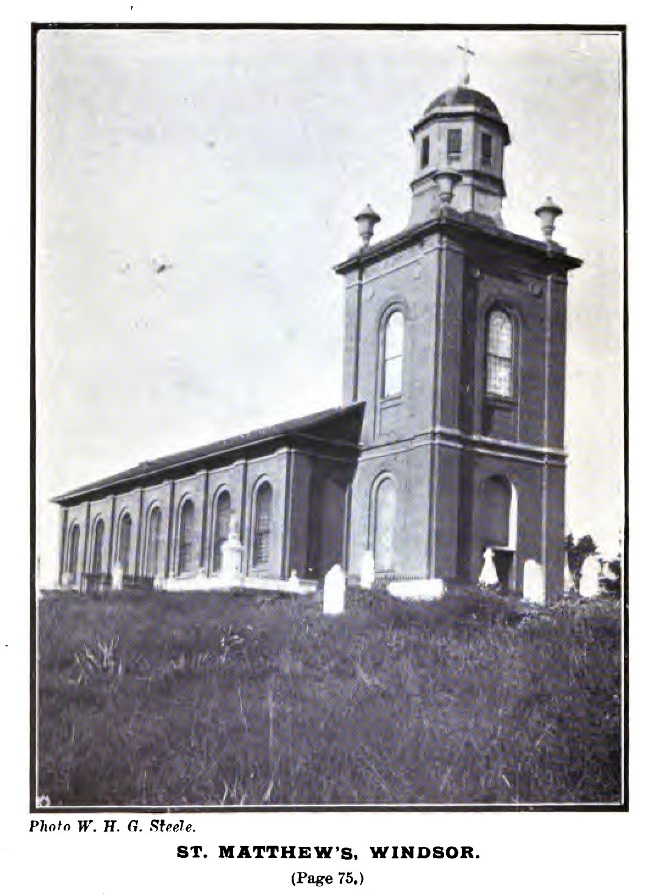 The following account of the funeral appeared in the Sydney 'Gazette,' 3rd November, 1810: — "In the mention of the death of A. Thompson, Esq., in the "Gazette" of last week, we should have added an account of the funeral, which took place, on Friday Se'nnight (which means seven night) had we in time received it. Between 12 and 1 in the afternoon, the remains of this much lamented gentleman were removed from his house on the Green Hills, which for the hospitality of its owner had been for many years proverbial, and conveyed to the Chapel on the Green Hills, whereat the Rev. Mr. Cartwright attended and delivered a very eloquent and appropriate discourse upon the occasion to one of the most numerous and respectable congregations ever assembled there, after which the ashes of this philanthropist were conveyed to the new burial ground, and these deposited in a vault in the presence of the multitude, who, it may be unexceptionally said, felt the most sensible regret in taking their last farewell of him whose life had been devoted to the service of his fellow creatures.
The following account of the funeral appeared in the Sydney 'Gazette,' 3rd November, 1810: — "In the mention of the death of A. Thompson, Esq., in the "Gazette" of last week, we should have added an account of the funeral, which took place, on Friday Se'nnight (which means seven night) had we in time received it. Between 12 and 1 in the afternoon, the remains of this much lamented gentleman were removed from his house on the Green Hills, which for the hospitality of its owner had been for many years proverbial, and conveyed to the Chapel on the Green Hills, whereat the Rev. Mr. Cartwright attended and delivered a very eloquent and appropriate discourse upon the occasion to one of the most numerous and respectable congregations ever assembled there, after which the ashes of this philanthropist were conveyed to the new burial ground, and these deposited in a vault in the presence of the multitude, who, it may be unexceptionally said, felt the most sensible regret in taking their last farewell of him whose life had been devoted to the service of his fellow creatures.
In the funeral procession the Rev. Mr. Cartwright walked foremost and was followed by Surgeons Mileham and Redfern, who had attended the deceased through the long and painful illness that brought to a conclusion an existence that had been well applied. Next followed the bier, attended by Captain Antill, A.D.C. to His Excellency the Governor as chief mourner. The Paul bearers were Mr. Cox, Mr. James Cox, Mr. Lord, Mr. Williams Mr. Arndell, and Mr. Blaxland. A number of gentlemen followed as mourners, and a long train, composed principally of the inhabitants of the settlement, followed in succession.
The following is a copy of the entry of his death in, the register of the Parish Church of Hawkesbury:— "Entry No. 5. Andrew. Thompson, Esq., of this Parish came to the colony in the ship ''Pitt," in the year of our Lord, 1792. Aged 37 years, and was buried October 25th, 1810. Robert Cartwright." A memo after this entry says : 'A. Thompson, Esq., was the first corpse buried in the new church yard at Windsor.' The inscription on his tombstone in St. Matthew's Churchyard read's as follows : —
SACRED to the memory of ANDREW THOMPSON ESQUIRE Justice of the Peace and chief Magistrate of the District of the Hawkesbury, a Native of Scotland, Who at the age of 17 Years; was sent to this Country where from the time of his arrival he distinguished himself by the most perservering industry and diligent attention to the commands of his Superiors. By these means he raised himself to a state of respectability and affluence which enabled him to indulge the generosity of his nature in assisting his Fellow Creatures in distress more particularly in the Calamitous Floods of the river Hawkesbury in the Years 1806 ,and 1809 where at the immediate risque of his life and perminant injury, of his health he exerted himself each time (unremittingly) during three successive Days and Nights in saving the lives and Properties of numbers who but for him must have Perished. In- consequence of Mr. Thompson's good Conduct, governor Macquarie appointed him a Justice of the Peace. This act, which restored him to that rank in Society which he had lost, made so deep an impression on his grateful Heart as to induce him to bequeath to the governor one-fourth of his Fortune. This most useful and valuable Man closed his Earthly career on the 22nd Day of October 1810, at His House at Windsor of which he was the principal Founder in the 37th Year of , his age, with (in) the Hope of Eternal Life. ' From respect and esteem for the Memory of the deceased,this Monument is erected by LACHLAN MACQUARIE, GOVERNOR of New South Wales
Before closing this sketch of Andrew Thompson we must mention that he had some bitter enemies in Sydney, though none locally, who painted him in a very different color. John Macarthur, referring to his death, says : 'It was an interposition of Providence to save the colony from utter, ruin; never was there a more artful or a greater knave.' In Bigges' report on the colony of New South Wale's, made in 1822, he describes him as using his wealth so as to gain an influence with the small settlers on the Hawkesbury, and also as a man of loose moral character.
But every fairminded historian will see that a man who won the esteem of three successive Governors, as well as of all the leading residents of the district in which he lived, including the clergymen, and at whose funeral the whole district followed their friend and patron, must agree that to call Andrew Thompson a bad citizen is a distortion of plain facts. Early Days of Windsor. (1914, October 9). Windsor and Richmond Gazette (NSW : 1888 - 1954), p. 9. Retrieved from http://nla.gov.au/nla.news-article85860782